#there's a reason why the show is so popular with white audiences folks!
Explore tagged Tumblr posts
Note
Good morning!! Almost 3 hours into my shift and I’m ready to shut AWL this shit down lol. Hope your day is going well.
Ok….
I know this probably sounds petty as hell but whenever I see a Black male actor paired with a yt/non-black or ambiguous Black love interest it almost always takes me right out of the story aaaand I have to debate on whether or not I wanna see it lol. It’s so overly done and you hardly see it in the reverse. Then I feel bad cause I wanna support the Black people in the movie/show but gahdamn I gotta sit through 1.5-2hrs or several seasons of this?
I think I’m experiencing some type of fatigue. Like I should not feel relief or surprise when I see an unambiguous Black woman being a love interest for a Black man in a movie or television show…cause it should be the fucking norm. Shit, it used to be the norm back in the day.
Especially cause we know it works and people want to see it. They keep tryna cater to a demographic that already has everything made for them. I’m over it. Black people date and marry Black people in real life, put it in the damn movie/show and stop playing in my face.
It can’t be that hard…or someone who works in that industry let me know. I know Black entertainers face more roadblocks than their yt counterparts so someone tell me somethin please.
Cause ummm I know for a fact if every yt male actor was constantly paired with a Black or non-white love interest there would be think pieces and cries of reverse racism 🙃. Look at how they acted when Halle got casted as Ariel….
Hey hey! Good morning/afternoon. Shut it down! I’m 3.5 hours into the day and the most I’ve accomplished is ordering lunch lmaooo. I’ll get to my real work post 2 pm.
It don’t sound petty at all bc same. I remember holding my breath when watching This Is Us because I just knew Randal/Sterling would be paired with a non-black/ambiguous woman. I was so happy he wasn’t that I locked right on in. It’s like when you walk around and see Black men with Black women in large numbers, you gotta wonder why the push to alter that perception exists in popular media?
That fatigue is so real. I’ve started getting super vocal about not watching white love stories. Not because I don’t think they’re worthy or attention or good stories, but I’m just looking for something else. Desperately. That’s why shit like Forever gets so much attention. Black people are TIRED and longing to see ourselves represented in ways that reflect joy and hope. Which is why I get so mad at people like Tyler Perry because you got all that money but keep telling the same sad ass stories. His audience could use some sappy romance! There has to be a reason this shit isn’t propped up. Is it us as an audience? Is it the gatekeepers? Like what’s really up? Why can’t we have those moments?
On the white actors being paired with Black women, the first thing people rush to do is tell Black women how that actor actually doesn’t like Black women. It’s just for the story. Which is usually true on top of all the backlash. Then it’s us getting punched on for no reason.
Don’t even get me started on Black gay/trans/non-binary folks getting even LESS of a chance to see themselves in love. Then the different body types and disabled folks. Older Black women. We all being left in the damn dust but they want our money.
4 notes
·
View notes
Text
The Fire Nation + Zuko’s Redemption
alrighty people asked for this analysis so allow me to try and coherently put my thoughts into a post
let’s get the obvious out of the way- zuko has a pretty solid redemption arc.
from a character and writing standpoint, his redemption is really well fleshed out. there is the constant repetition of needing to actively work towards improvement, there are moments where he gets what he thinks he wants and is still unfulfilled, there is the fact that he doesn’t get better overnight and how severely his familial trauma affects him when it comes to steering him onto the right path. people have analyzed this over and over, and for good reason. it’s interesting to pick apart and watch his growth as the show progresses.
however, there is a small issue with it overall.
zuko’s redemption (as well as part of the show’s narrative) goes from humanizing a fire nation character to redeeming and humanizing the fire nation as a whole alongside the character.
this is an issue because it presents this underlying message of “if one fire nation character can be good, then the rest of the fire nation can be good as well!”, or “if one fire nation character can be redeemed, then all fire nation character can/should be redeemed!”
in the grand scheme of things, this really doesn’t hold up at all.
for one, zuko’s circumstances were way too specific to be applicable to every single fire nation character. he is the crown prince of the fire nation who suffered abuse under his father, was banished and sent to find the avatar at 13, had his uncle with him to guide him towards a better path, and his grandfather was the late avatar roku. you can’t copy and paste these very specific circumstances onto any fire nation character, nor does having these circumstances to begin with immediately qualify a character for redemption.
furthermore, the fire nation is imperialist, and is actively imperialist over the course of the show. there are not many characters, if any, who weren’t complicit with what the fire nation was doing at some point over the course of the show.
zuko still: is the crown prince of the fire nation, called multiple people peasants, crashed a ship into the southern water tribe looking for the avatar, burned down kyoshi island, stole from various earth kingdom refugees both as and not as the blue spirit, hired a bounty hunter and an assassin when looking for aang, and more. azula still: is the princess of the fire nation, also called multiple people peasants, used power and manipulation to keep people in line, attacked and stole the identity of the kyoshi warriors, colonized ba sing se (which is much more serious than people realize), took over the dai li and brought them to the fire nation, murdered the avatar, and more.
as the show progresses and we lose characters who are explicitly evil and one-sided (such as commander zhao) and move into moral ambiguity, it’s not just the morality of the characters with which we are presented that are called into question. it’s their very identity as fire nation, and the narrative, which begins to shift in favor of redeeming zuko, also shifts in favor of the fire nation, which is something explicitly stated by the creators.
think about how many episodes in season 2 and 3 are focused on the fn in some way, shape, or form. you develop sympathy for zuko, and, by proxy, the imperialist monarchist nation behind the war.
it isn’t wholly intentional, but the fact that the message of “not ALL fire nation” is still there really rubs me the wrong way, especially considering that the show ends with zuko as the new firelord, instead of abolishing the monarchy altogether. zuko is still the crown prince- it doesn’t matter if he’s “good” now, he’s still continuing the monarchy and benefitting from this system of power. zuko being the firelord instead of ozai won’t change what truly corrupted the fire nation at its core.
i’m aware that this is somewhat explored/deconstructed in the comics, but its handling of the politics regarding of the fire nation still enforce this underlying message, and also redeem other people who actively assisted in the imperialism and colonization, such as the rough rhinos.
bryke’s inherent favoritism of both zuko and the fire nation leaves the audience with a really skewed message regarding the severity of the fire nation’s crimes and impacts on the rest of the nations as a whole, and it’s really unfortunate how sympathetic the literal colonizers become as the show progresses. it’s humanizing, which is good to do with villains sometimes, and can be done right, but when the creators of the show are white, along with a large majority of the writing team, you really have to wonder why exactly said colonizers are humanized to the sharp degree they are in the show.
#there's a reason why the show is so popular with white audiences folks!#there's a reason why the redemption arc is so praised!#anyways i hope you guys don't get the takeaway of i hate zuko because i actually really enjoy him in canon#i just have critiques that are applicable to not only his character but the show as a whole#so this is my analysis#zuko#atla zuko#zuko atla#azula#atla azula#azula atla#atla#avatar the last airbender#atla meta#meta#character analysis#original#pinned
182 notes
·
View notes
Text
Ever get so upset you make a Tumblr account to vent?
I haven’t even listened to The Penumbra Podcast yet but it’s on my list because it’s insanely popular and the cosplays I’ve seen are hot as hell (A+ to all the cosplayers I’ve seen you’ve done great work). Now, with the recent news surrounding the podcast, I’ll wait till it’s done if I ever do get into it. I’m Asian and part of the LGBT community but I’m not nonbinary so I can’t say much about the trans represention in the art but I wanted to add my two cents on the matter as a person of color and someone examining the situation from the outside. Also, before I get deeply into it, I’m not the only person of color with opinions on this matter so if people have their own frustrations and criticism with the racism in The Penumbra Podcast and/or the new artist they hired, definitely listen to them too. These are my own personal opinions, and I’m sure other people will disagree and that’s fine. We’re all going to have different views on this so bear that in mind. Also, feel free to correct me or add anything if I’ve missed some information. Here’s a great breakdown of the whole situation for those that don’t know what happened. Finally, I was very hesitant to post this, but I felt it was important because I make a statement at the end on how race should be presented in a podcast format so if you are interested in making a podcast and want to have a diverse range of characters, please skip to the end to read those thoughts.
I’ll start off by saying, I’m not even that upset with the new artist that The Penumbra Podcast hired. I know that statement alone is controversial but I don't personally know them, and I’m not going to judge who they are as a person by a few pieces of art they’ve made. They are the least of the problems that I have here. Since the announcement and the backlash, I’ve been scrolling through the artist’s Instagram account and I can tell why people find the designs offensive, but I’m also comparing the designs to the artist’s other work, and I honestly believe that’s just their style. They’ve exaggerated the features of just about every character they’ve made, regardless of race or gender. From what I’ve seen the sharp angles and overly round curves in the anatomy that make some of the character’s features more jarring are how they prefer to draw. I’m sure they’re capable of drawing more realistic proportions but for the most part they’re art aims to call attention, be bold, and create distinguished features. Not inherently a bad thing on its own.
And yeah I’d understand the issue if this were a scenario where the artist heard how these characters acted in the podcast and thought “hey, obviously this character is a black woman because they are super strong and therefore must have big muscles, no other woman could look like that” or “hey, this character has to be Asian because they act super seductive sometimes better draw them as such.” But from my understanding the race was already decided by previous official artists and a general description of the characters were already generated by the audience, similar to how The Magnus Archives leaned towards drawing scrawny Jon with black, greying hair and dark skin. The new artists couldn’t really change those features even if those features aren’t described in canon because a depiction that strayed too far from popular fandom interpretation would make the character’s unrecognizable to the fanbase.
I think the reason this became such a big issue for most people is because the new Penumbra artist used their exaggerated art style when making these characters and people of color and nonbinary folks already see themselves drawn as these exaggerated caricatures all the time (with those images being used to further discriminate against them). I’m sure the artist didn’t mean for their art to be offensive, but that of course doesn’t change how it was received.
According to some, the poses and expressions the artists chose did not fully represent the characters entirely and only served to further perpetuate harmful stereotypes, and I’ll have to take their word for it because I still haven’t listened to the podcast so I have no idea how the characters act. But again much of the criticism is based on the one line-up and doing a deeper dive into the artist’s work I managed to find artwork that was much less offensive. Here some art where Vespa is depicted in a non-violent pose and one where Vespa is in a threatening pose but not an overly violent one. Here is Peter drawn in a non-seductive pose. Hopefully, the artist truly does keep the criticisms in mind as they work on the new official art. I’m just not the type of person that wants to get the pitchforks out and cause this particular person to lose a job they seemed really excited about over their old character line-up, especially when that person is also part of a marginalized group.
Again, that’s just my opinion on that particular artist. Those who are offended by their art are still valid in how they feel, and the artist should absolutely take their criticism to heart to better how they represent the characters.
What I’m more upset about is that I think The Penumbra Podcast should never have released official art for their characters in the first place and that’s their mistake that they refuse to own up about. They have made it clear that the story was never meant to portray characters of colors, a fact emphasized by the fact they hired mostly white actors from the start. They only started releasing art of the characters to get a profit. And the thing is they know what they did was wrong. All I had to do was search Penumbra Podcast racism and there is a note on their website saying that they archived some old official art.
“We have discontinued all Penumbra merchandise that uses the original character designs, and in the meantime, any profits on the sales of that merchandise will go to the For The Gworls project. We also realize that the depiction of these characters as POC, while not appropriate for us to use in our marketing and merchandise, has nonetheless become personally meaningful to many POC listeners. For that reason, and because we do not wish to distance ourselves from our mistake, we are keeping these images on our website for archival purposes. Though we do want to make it clear that many of the main/featured voice actors are white and that we did not write the characters to represent any specific POC experience, you are, as always, free to imagine these characters in any way that you like.”
I went to their shop and they still sell posters and pins with the character’s faces on them, but they are donating it to a good cause so hopefully that stays the same. However, I still find it a little uncomfortable that they are still selling character merch and have plans to continue selling character merch. They have no right to dissuade the fans that already found representation in the characters, but they also have no right to profit off the representation that was built, regardless if they made the story.
Let’s compare this to another piece of popular media. I love Avatar the Last Airbender and, I liked the ATLA voice actors just fine but there should have been more people of color doing voice acting behind the screen too. The voice actors for that show were mainly white too, however, the creators knew that they would be making poc characters. That’s what makes the difference. Did they still choose to go with mostly white voice actors? Yes. Could they have done better and pay more people of color? Also yes. But I’m not as furious at them because they did their research on the cultures they were basing the ATLA world off of and intentionally gave us a show where Asians could see characters that looked like them represented on the screen. The Penumbra Podcast did not do any of that. Again, they openly admitted that it was never their intention to make the character’s people of color when they made the podcast so that goes to show no research was made to properly represent specific cultures. The color of the character’s skin in their official designs therefore became more of aesthetic choice rather than representation, and it wasn’t even their aesthetic choice to begin with!
Race isn’t a color you can just throw onto the character because you feel like it. So I want this to be a lesson to anyone that wants to make a podcast: if you want to include poc characters please do some research into the cultures you plan to represent the way you would with any other form of media. Just because the audience can’t see the characters and just because it’s harder to smoothly introduce the character’s appearance doesn’t mean you’re allowed to be lazy on how you present the characters. Do research before you start writing the first episode and take the time to hire poc actors. Hiring poc actors is actually the least that can be done to show representation. Also, since the audience cannot visually see the race of the characters on a podcast and it can’t typically be described the way you would in a book, you’ll have to be creative. It’s not my job to say how, but my suggestions would be, before the fans come up with their own image of the character, you need to establish race in the first few episodes or release character profiles on a website so that the fans know you canonically intended the characters to be of a certain race even if you aren’t able to mention it in the actual podcast. If you are unwilling to do any of these then the best route is to avoid stating race at all and allow the audience to build their own representation into your form of media. However, once this happens, you are not allowed to profit off popular fan interpretations. You lose all rights to create official art or images of the characters. You cannot use “we have a diverse cast of characters” when you market your story. It doesn’t matter whether you created the content or not, you did not create the representation for those minority groups.
It’s one thing for fans to build their own inclusivity into a form of art like a podcast, but it’s another thing for the creators who never worked to make the representation happen to take advantage of the representation that the listeners built for themselves. Thank you for attending my TedTalk.
#the penumbra podcast#podcast#race#the magnus archives#diversity in podcasts#diversity#tpp#tpp fanart
126 notes
·
View notes
Text
“A Queer Who Cares” : The Intersection of Class and Queerness in Tokyo Godfathers

Tokyo Godfathers is a Japanese animated film, made in 2003, that follows the adventures of three homeless friends on Christmas Eve in Tokyo, Japan. Throughout the movie, we follow Hana, a transwoman and former drag queen, Gin, a middle-aged man with a gambling addiction, and Miyuki, a teenage runaway, as they find a baby in a trash can and spend Christmas Day trying to reunite the child with her mother. A comedic adventure quickly ensues, as the chaotic but loving trio, do their best to take care of their new baby, solve the mystery of her appearance, and all the while combat the dangers and prejudices that come with being homeless. Though predominantly a comedy, the film also strays away from its humorous tone and delves deep into the characters’ complex backstories, emotionally exploring the myriad of reasons why Hana, Gin, and Miyuki are homeless and why getting the baby back to her mother is so important for each of them. Directed by the famous Satoshi Kon and loosely based on the 1913 novel “The Three Godfathers”, the film explores themes of parenthood, found families, classism, transphobia, and addiction, and illuminates the complex ways in which these forces interact and impact daily life. In essence, Tokyo Godfathers effectively explores themes of transphobia and the intersection of classism and queerness, and though not entirely unproblematic, is unique and powerful in its complex characterization of both Hana as a character and the oppressions she faces as a transwoman who is homeless.
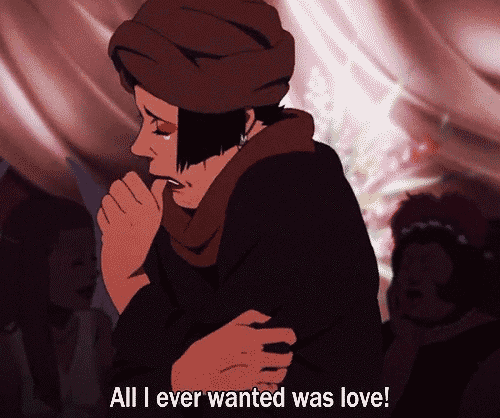
(Hana speaking about her desire to be loved)
Before beginning, it is important to note that the following analysis is of the 2020 English dubbed re-release of Tokyo Godfathers by GKIDS. As of now, there are many fan-subbed versions of the film circulating on the internet that misgender Hana in their subtitles. The GKIDS re-release does not so I will not be addressing that form of transphobia in my analysis. Similarly, in the original Japanese version, Hana is voiced by a man, and the fluctuations of her voice, from high and feminine when she is happy, to low and masculine when she wants to be intimidating, is present and follows a very transphobic trope in comedy. In the GKIDS dubbed version, Hana is voiced by Shakina Nayfack, a transwoman, actress, and activist, and these vocal fluctuations are not present so, once again, I will not be addressing that form of transphobia, as it was not present in the updated version that I watched.

How Shakina Nayfack used her voice to reclaim trans representation in animation
(A short article on Shakina Nayfack, the English voice actress for Hana in the 2020 GKIDS re-release)
youtube
Though Tokyo Godfathers does not have the popularity or mainstream attention to be considered a breakout text, it’s humanizing and complex characterization of Hana breaks traditional transphobic tropes, particularly in comedy, that lends itself to “creat[ing] small cracks in the glass ceiling of cultural consciousness and makes room for future breaks” (Cavalcante, 2017, p. 4). Hana is the main protagonist of the film. She is both the center of comedic relief, the leader of her found family and the driver of the plot as a whole. It is through her desire to fulfill her dream of becoming a mother, and her desperate need to understand why parents abandon their children (as her parents did to her), that motivates her, and in turn, her friends, to find the child’s parents themselves, instead of going to the police. It is in this complexity that Hana, “breaks historical representation paradigms” of both trans characters and queer characters as a whole (Cavalcante, 2017, p. 2). In her desperate search to love and be loved, Hana is immediately humanized, her identity centered in love and family, and not in her gender or sexuality, as so many queer characters are. In addition, she is not portrayed as “sexless” as is the norm for queer characters, wherein they can exist in media as long as their love stories and intimate desires do not. Though very subtle, Hana is the only character in the movie that has a love interest, Gin, and she had a boyfriend, who died, but is still a key part of her characterization. Though these love stories are not centered in the film, they are the only ones in the movie, and this exclusive existence, unique to Hana, illustrates their importance to both the themes of the movie and Hana’s character.
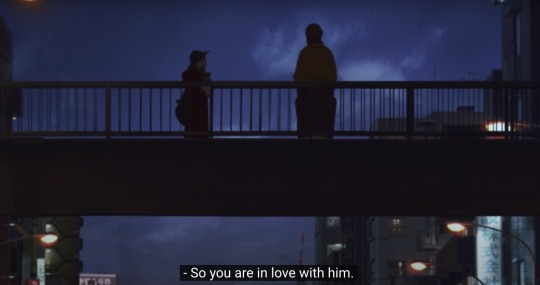
(Miyuki asks Hana about her feelings for Gin)
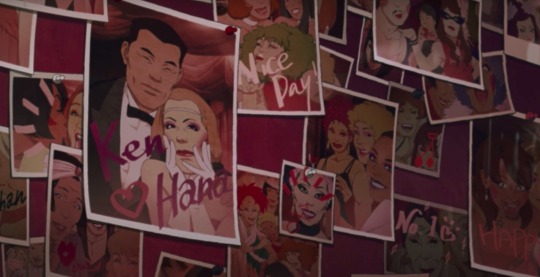
(A photo of Hana and her ex-boyfriend Ken at the club she once worked at)
That is not to say that the queer representation in this film is by any means perfect. As mentioned, the movie is a comedy and thus falls into the historical “preponderance of these representations occurring in the comedy”, especially given that Hana is the comedic center (Dow, 2001, p.130). Even more so, there are instances in which Hana’s trans identity is stereotyped and used as the joke itself. In one scene, she flirts with a cab driver knowing that he is uncomfortable by the fact that she is a trans woman, and his transphobia is framed as comedic. She also has a very flamboyant personality, with sharp emotional highs, and equally dramatic lows, that once again plays into stereotypical representations of transwomen as over-the-top and overly dramatized to the point of ridiculousness. In line with this, her previous line of work was as a drag queen, and though scenes of her in the drag community are dominated by a sense of love and community, it still plays into already established tropes of transwoman living as a performance. In these ways, her representation at times leans towards the role of the “clown...putting on a show for The Other” where it is “never quite clear whether we are laughing with or at this figure” (Hall,1995, p. 22). However, as mentioned above, Hana’s complex and nuanced backstory, combined with her frequent acts of heroism and her leadership role, make it so she is deeply humanized. Though her dramatic personality falls into these stereotypical tropes at times, it does not detract from her character arc of motherhood and finding love, a nuance that is missing from many stories of trans women in media.

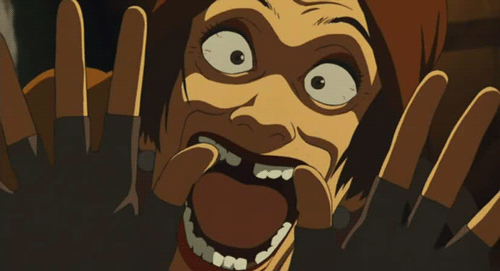
(As pictured, Hana’s emotions are very dramatized and quickly jump from very high to very low)
This nuance is heightened through the intersection of classism and queerness, which is an equally prevalent theme throughout the film. In particular, class struggles are illustrated through medical care. At one point, Hana falls ill, and Gin is forced to give away his life savings in order to pay for her treatment. It is also here where Hana’s gender identity is questioned, as the hospital houses her in the men’s ward, and she explains that she “is not pleased with this”. This particular intersection of class and queerness within a medical setting is impactful given the long and “oppressive role of medicine in trans people’s lives” (Keegan, 2016, p. 607) and the strong tendency of media to tell trans folks stories, about both life and transition, in a way that is medicalized. For Hana, the discrimination she experiences at the hospital, and her inability to pay for her treatment, illustrate the violence of intersecting oppressions of queerness and homelessness in medical systems, while also straying away from the problematic representation of trans folks that are centered around a rhetoric of medicalization. More visually, the family is also a key illustrative example of how class and queerness are explored. The trio is constantly visually contrasted with traditional Japanese families in a variety of settings. This harkens back to ideas of “alternative forms” of families that queer folks create and this difference is visually exasperated by the trio’s homelessness, making them stand out in whatever space they are in (Keegan, 2016, p. 607).

(An angel asks Gin if he would rather have her magic or an ambulance. He chooses the ambulance.)
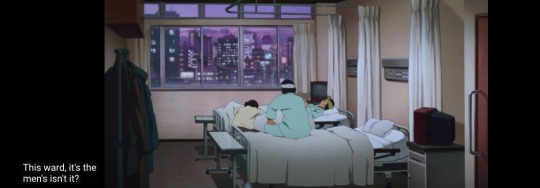
(Hana in the hospital. The subtitle reads “This ward, it’s the men’s isn't it?”)
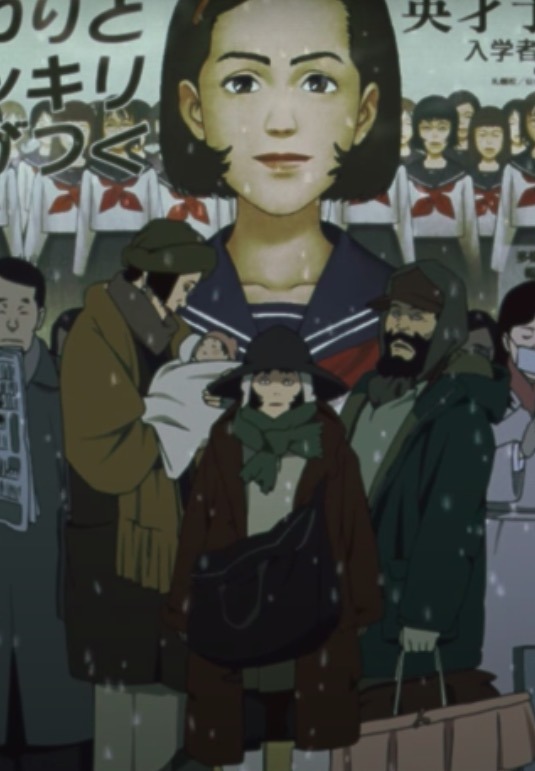
(One of many scenes where the trio is set up in familial positions)
As a queer, white woman living in the United States my subject positionality had a great effect on how I consumed the movie. Most notably, I was born and raised in Western society, and given that this film is Japanese and made for Japanese audiences, there is a variety of cultural norms and perceptions that I did not pick up on because of my lack of familiarity with them. In the same vein, I watched this movie translated into English and, as with every translated work, there are words and subtle, yet important, nuances in the language that were very likely lost to me as a viewer. My identity as a queer woman made it so that I was drawn to Hana as a character and was very moved by her deep desire to be a mother. The movie is steeped in images of Hana and her friends encompassing the idea of a non-traditional family, and since I would love a family of my own one day and I expect that to look different than the dominant nuclear family norm, I really focused my experience on the variety of nontraditional families that this movie shows, all of them as loving as the next.
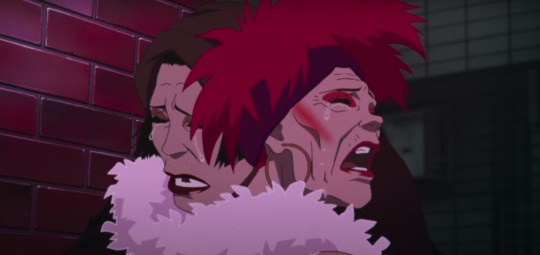
(Hana and her drag mother reuniting)
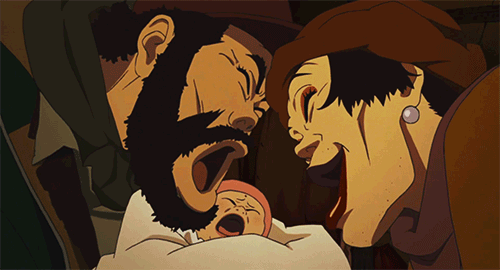
(Hana and her family)
As a whole, Tokyo Godfathers, though not without its faults, is a refreshing take on the traditional feel-good Christmas movie trope, delving into class and queerness, and using the two to explore what it really means to be a family that is loving and kind. Spoiler alert, that family looks a little something like one ex-drag queen, one man with a gambling addiction, a teenage runaway who loves cats, and their baby they found in a dumpster.
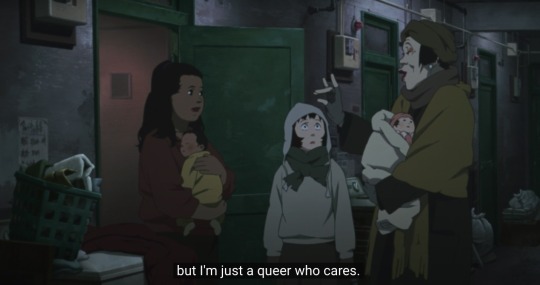
Sources
Dow, Bonnie (2001). “Ellen, Television, and the Politics of Gay and Lesbian Visibility.” Critical Studies in Media Communication 18(2), 123-140.
Cavalcante, Andre (2017). “Breaking into Transgender Life: Transgender Audiences’ Experiences With ‘First of Its Kind’ Visibility in Popular Media.” Communication, Culture & Critique, 1-18.
Keegan, Cáel (2016). “Tongues without Bodies: The Wachowskis’ Sense8.” Transgender Studies Quarterly 3(3–4), 605-610.
Hall, Stuart (1995). “The Whites of their Eyes: Racist Ideologies and the Media,” in Gender, Race, and Class in Media 3rd ed., pp. 18-22.
#tokyo godfathers#queer studies#Queer Movie Review#trans woman#trans representation#found family#christmas movies
196 notes
·
View notes
Text
Late Night, a feminist review
This is another old essay, on my favourite movie Late Night, from the coolest class I ever took, Women in Pop Culture. Writing this essay actually made me realize I want to more closely study competitive femininity one day! I also remember this was an essay where I wished the word count was higher, because I love this movie and had a lot to say!! lol, maybe one day I will write more.
if you read, I hope you enjoy!
Mindy Kaling's first feature film, Late Night, is a dramatic comedy starring Emma Thompson as Katherine Newbury, the only female late night talk show host in America. Kaling co-stars as Molly Patel, an Indian woman selected as a diversity hire for Katherine’s writing staff. The film is a pointed remark on the lack of diversity in Hollywood writing rooms, as well as the cultural shifts that are bringing about change in the industry. Molly Patel’s intersectional feminisim not only builds her relationship with Katherine but also attests that a truly feminist character has less limitations than most depictions of empowered women.
Five minutes into the film, we see Katherine Newbury fire one of her writers after he asks for a raise because he has just had a second child with his wife. Katherine is more than pleased to inform him of why this is a sexist request. “You’re asking for a raise, not because of any work-related contribution,” she says, “but simply because you have a family. And that’s why in the 1950’s, family men were promoted over the women they worked with.” It is understood from this scene that Katherine approaches the world from a place of education and with feminist intent. However, the writer she is firing quickly retorts, “There are no women on this staff. And the reason there aren’t any women is because you hate women.” This is a shock for both Katherine and the audience because, how can a self-proclaimed feminist be accused of hating women?
An internalized competitive feminity is revealed in Katherine. Angela McRobbie explains competitive femininity as, “an amplification of control of women... so as to ensure the maintenance of power structures...Feminism, at the same time, is made compatible with an individualising project and is also made to fit with the idea of competition” (McRobbie, 2015, pg. 3). Katherine is the only female late night host in television, yet she is an upper class, white woman. Her economic background alone allows her to occupy a place of privilege in a system that relies on the oppression of the lower classes. While it is a triumph that Katherine is a successful female host, she fails to reflect on possible extensions of this triumph, such as hiring other women for her staff. Therefore, Katherine’s feminism is a self-serving feminism. “It seems then there is a battle to ensure that the new popular feminism which emerges or which holds sway is one which discards the older, welfarist and collectivist feminism of the past, in favour of individualistic striving” (McRobbie, 2015, pg. 4). Competitive feminity is a sly instrument in our society. It allows for the success of certain women over others, while leaving “the existing patriarchal regime relatively untouched” (McRobbie, 2015, pg.17).
As the media we see often reflects certain aspects of the society we live in, Mindy Kaling is making a purposeful statement that writing rooms in the entertainment industry are disproportionately white, male and upper class. As Douglas Kellner details in, “Cultural Studies, Multiculturalism and Media Culture,” the entertainment industry plays a massive role in our society’s culture. “Media images help shape our view of the world and our deepest values...Media stories provide the symbols, myths and resources through which we constitute a common culture and through the appropriation of which we insert ourselves into this culture” (Kellner, 2015, pg. 7). It is important to view Late Night with a cultural studies perspective. Kaling’s character Molly Patel is very clearly both a fan and critic of popular culture, and Katherine Newbury is considered an international icon. Furthermore, Andi Zeisler, in “Pop and Circumstance: Why Pop Culture Matters,” demonstrates the significance of examining phenomena such as cultural icons “in the context of its social value, influence and ideology” (Zeisler, 2008, pg. 5). We see examples of strong cultural reactions in Late Night when Katherine receives negative backlash from both journalistic and social media for attempting to embarrass one of her guests, as well as having an affair with one of her writers. This is because Katherine’s status as an icon places her in a space of perpetual examination.
The introduction of Kaling’s character, Molly Patel, is the biggest shift in the plot. Molly is the opposite of Katherine in that she is exceedingly earnest, prone to hesitation, attended a community college and is not white. Bell hooks identifies from her experience teaching cultural studies that, “everyday folks from all walks of life were eager to share thoughts and talk critically about pop culture” (hooks, 1994, pg. 4). If we understand popular culture and its various productions paired with its widespread influence, what can possibly justify the fact that it is dominantly created by white, upper class men, and not a more accurately diverse portion of the population? Molly raises this issue in the film, urging Katherine to use her perspective as a woman in her comedy. Soon, the entire staff is branching out their writing in order to be more embracing of their audiences. Although it is a comedy, not a superhero film, a connection can be drawn to feminist heroes and how they achieve their goals through collective effort (Curtis and Cardo, 2018). It is in this way that Molly represents a more inclusive feminism. Her question of, “how can I help make this show better?” comes from a headspace of feminist unity. Not like Katherine’s earlier self-serving feminism, Molly asks, “How can I help further the cause of feminism?”
Ultimately, Late Night is an incredibly funny film that successfully tackles feminist and cultural issues. There is room for more than just one empowered woman in the film, and they experience their empowerment in unique ways. Initially, Katherine Newbury’s competitive femininity limits her, and this contrast in her feminism is a reminder of our society’s culture. As bell hooks states, “we must be willing to courageously surrender participation in whatever sphere of coercive hierarchical domination we enjoy” (1994, pg. 6). The introduction of Molly Patel and her desire for a more inclusive and diverse work environment proves that the best way to act as an empowered woman, is to lift up and empower those around you.
15 notes
·
View notes
Text
Discredit Pt. 2: More Recommended Reviews For A.Z. Fell’s
Alright, folks. Some notes first:
1. You all rock. I’m sending out 20k+ virtual hugs for all the notes I NEVER expected to get on this nonsense.
2. This is probably the final section, just because I’m not sure I can adequately follow up part one and it might be foolish to attempt it here. Let alone twice. But for now, here we go.
3. Kudos to the anon who reminded me of Aziraphale’s cash-only policy <3
4. Nicole Y’s review is based off an actual comment I read years ago, but heaven only knows where online it was. I’ve got the memory of a goldfish.
5. Trigger warning for the use of a queer slur in this. It’s the same review as above, number 5 if you want to avoid it.
6. There’s a text-only version of just the reviews at the end, after all the images. I’ll upload that to my Sparse Clutter collection on AO3 in a bit.
Bonus 7. People thinking this is a real shop deserve all the good things in this world.
That’s all I’ve got. Hope you enjoy! 👍
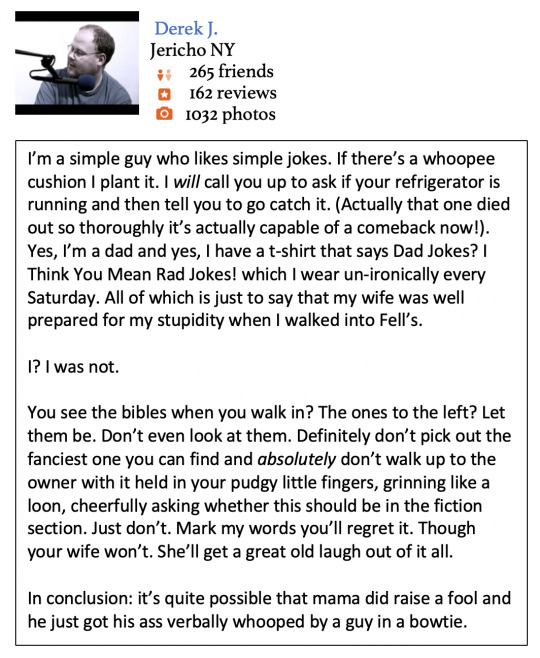
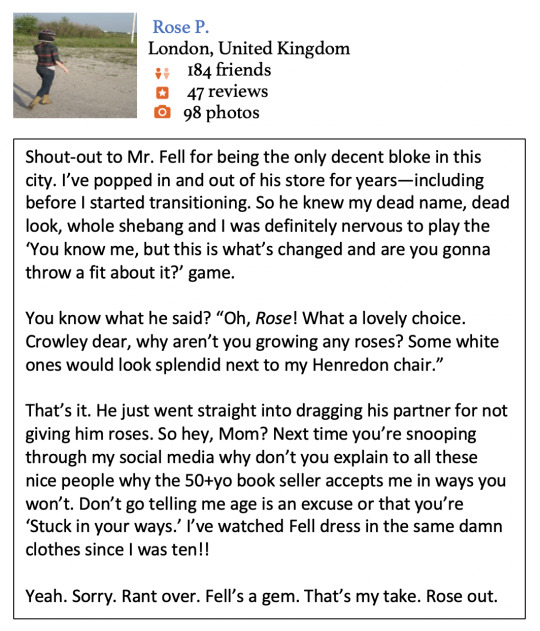
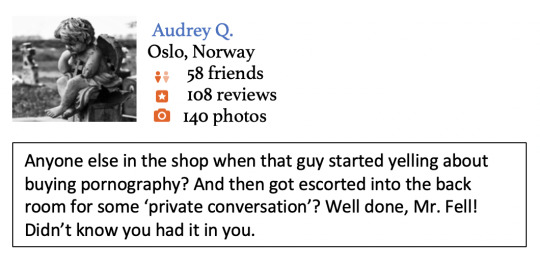
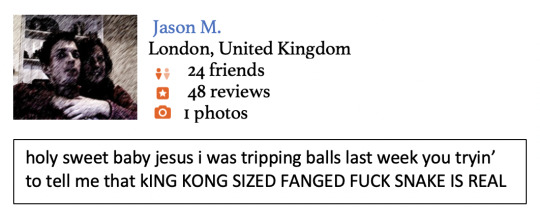
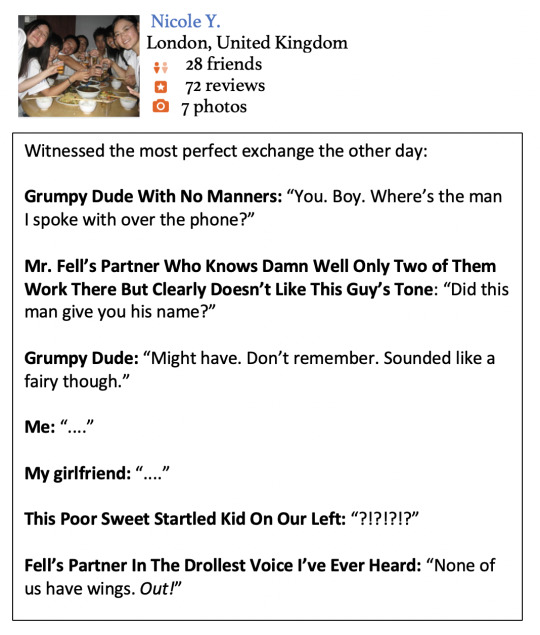
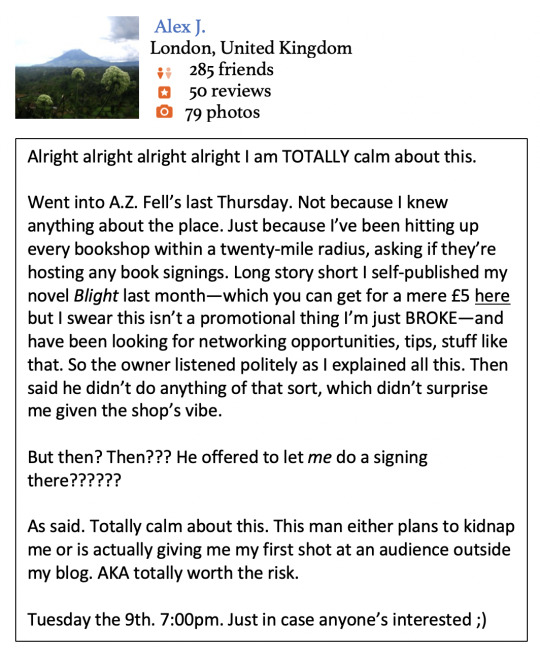
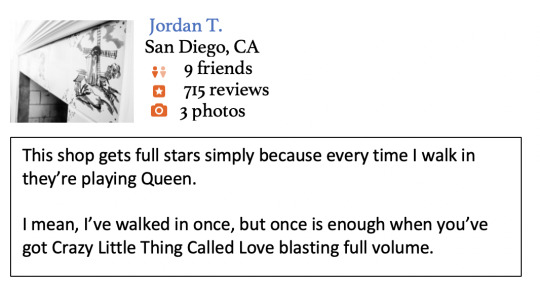
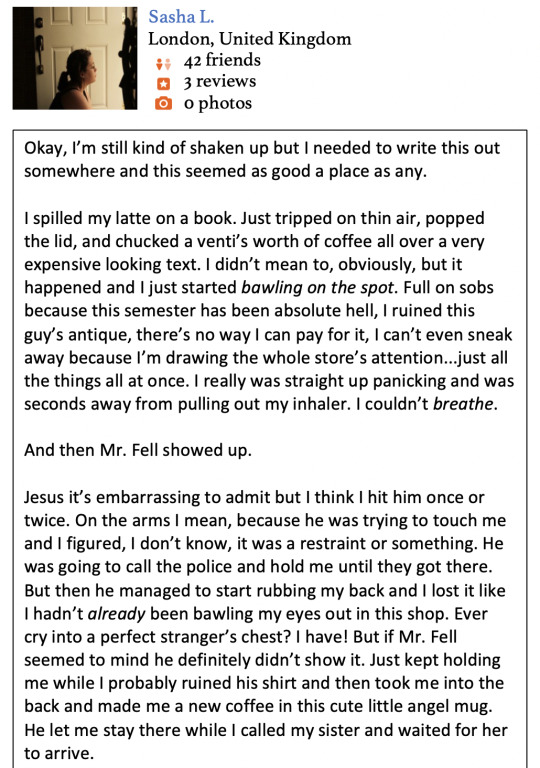
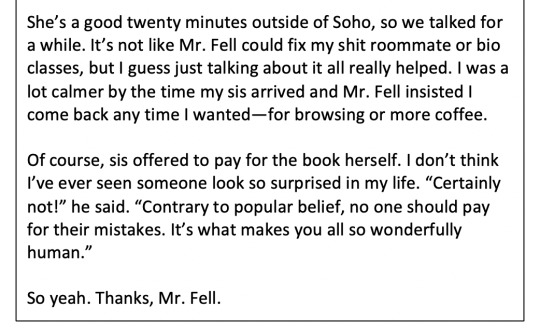
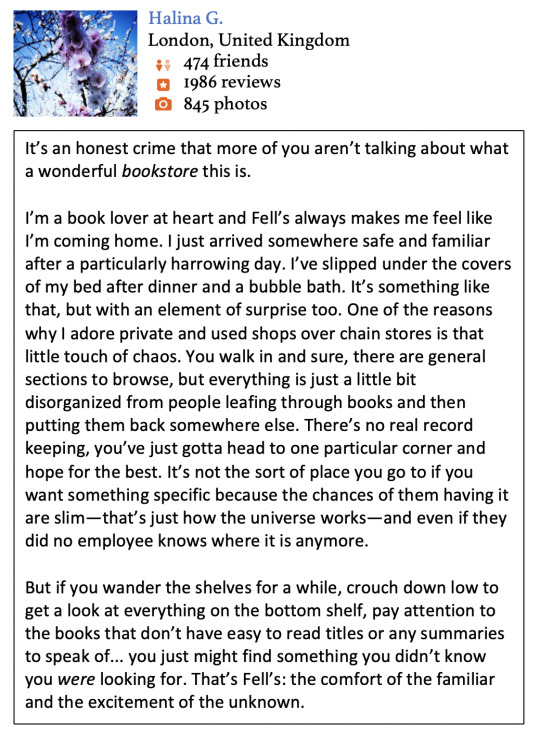
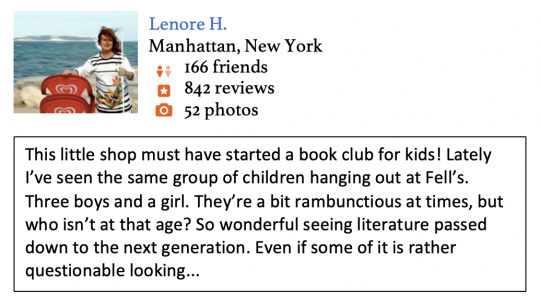
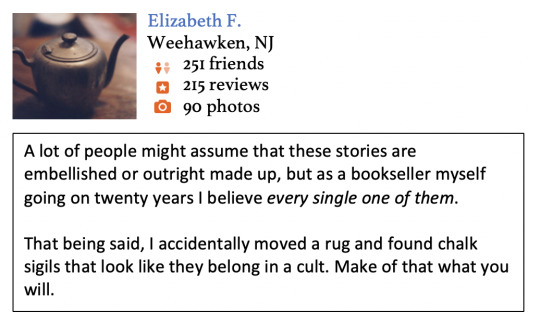
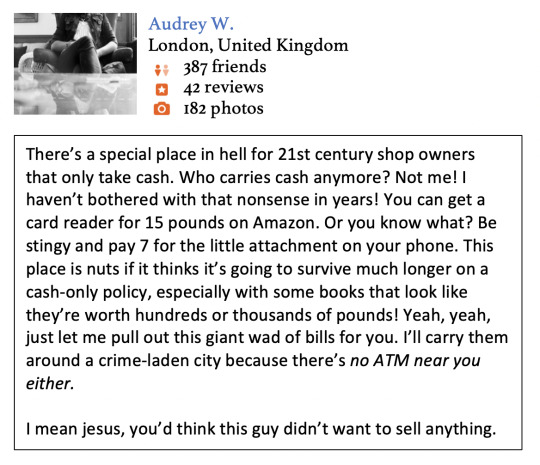
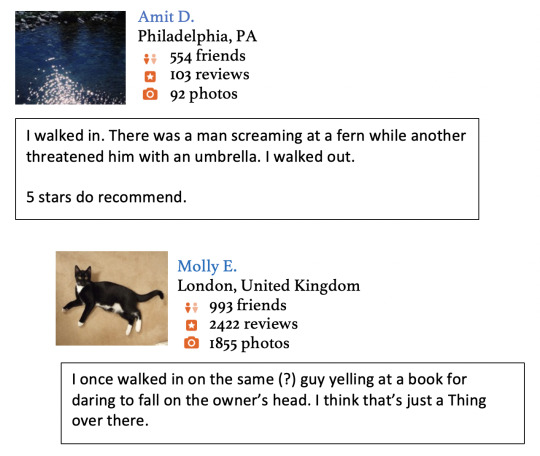
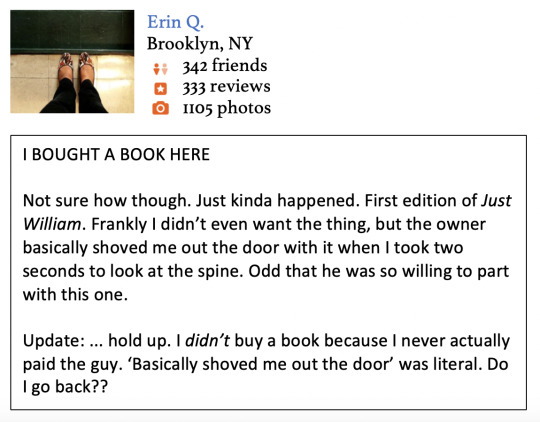
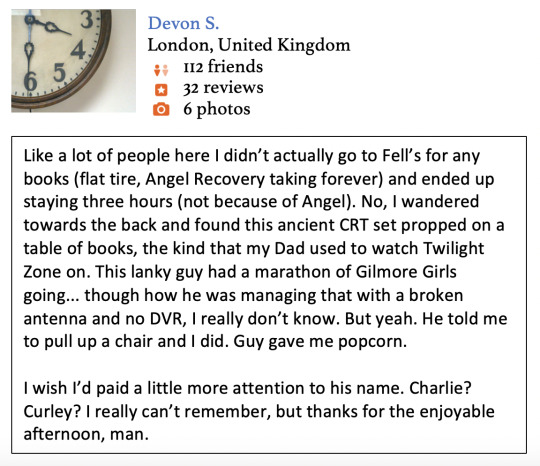
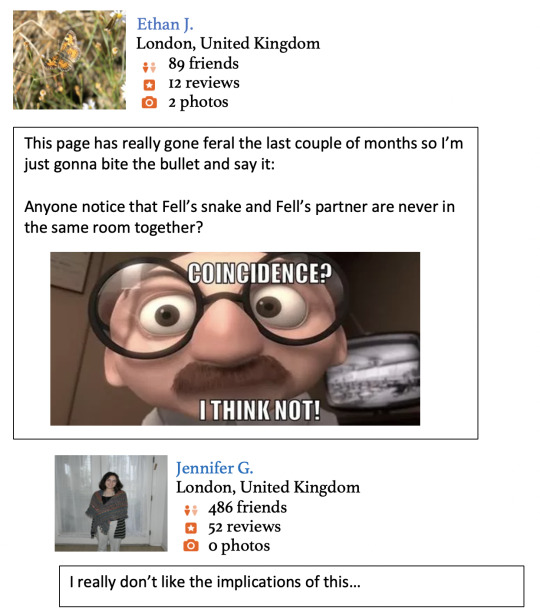
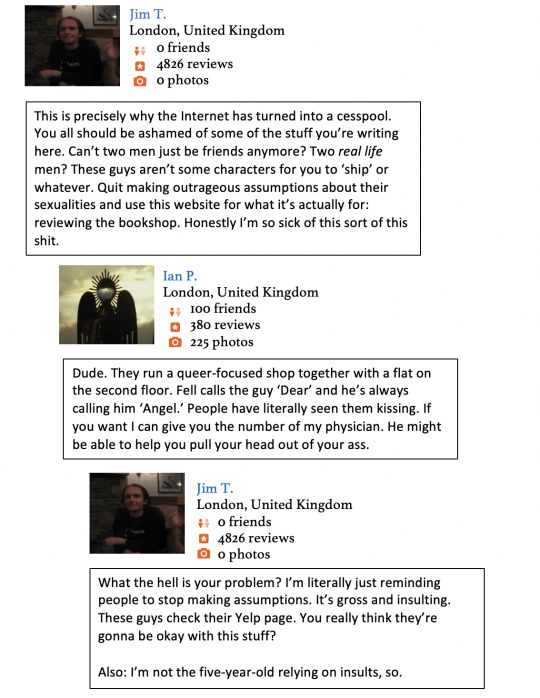
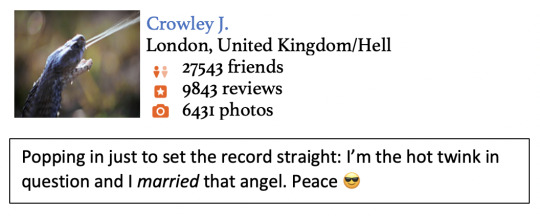
****************************************************************************
I’m a simple guy who likes simple jokes. If there’s a whoopee cushion I plant it. I will call you up to ask if your refrigerator is running and then tell you to go catch it. (Actually that one died out so thoroughly it’s actually capable of a comeback now!). Yes, I’m a dad and yes, I have a t-shirt that says Dad Jokes? I Think You Mean Rad Jokes! which I wear un-ironically every Saturday. All of which is just to say that my wife was well prepared for my stupidity when I walked into Fell’s.
I? I was not.
You see the bibles when you walk in? The ones to the left? Let them be. Don’t even look at them. Definitely don’t pick out the fanciest one you can find and absolutely don’t walk up to the owner with it held in your pudgy little fingers, grinning like a loon, cheerfully asking whether this should be in the fiction section. Just don’t. Mark my words you’ll regret it. Though your wife won’t. She’ll get a great old laugh out of it all.
In conclusion: it’s quite possible that mama did raise a fool and he just got his ass verbally whooped by a guy in a bowtie.
***
Shout-out to Mr. Fell for being the only decent bloke in this city. I’ve popped in and out of his store for years—including before I started transitioning. So he knew my dead name, dead look, whole shebang and I was definitely nervous to play the ‘You know me, but this is what’s changed and are you gonna throw a fit about it?’ game.
You know what he said? “Oh, Rose! What a lovely choice. Crowley dear, why aren’t you growing any roses? Some white ones would look splendid next to my Henredon chair.”
That’s it. He just went straight into dragging his partner for not giving him roses. So hey, Mom? Next time you’re snooping through my social media why don’t you explain to all these nice people why the 50+yo book seller accepts me in ways you won’t. Don’t go telling me age is an excuse or that you’re ‘Stuck in your ways.’ I’ve watched Fell dress in the same damn clothes since I was ten!!
Yeah. Sorry. Rant over. Fell’s a gem. That’s my take. Rose out.
***
Anyone else in the shop when that guy started yelling about buying pornography? And then got escorted into the back room for some ‘private conversation’? Well done, Mr. Fell! Didn’t know you had it in you.
***
Alright alright alright alright I am TOTALLY calm about this.
Went into A.Z. Fell’s last Thursday. Not because I knew anything about the place. Just because I’ve been hitting up every bookshop within a twenty-mile radius, asking if they’re hosting any book signings. Long story short I self-published my novel Blight last month—which you can get for a mere £5 here but I swear this isn’t a promotional thing I’m just BROKE—and have been looking for networking opportunities, tips, stuff like that. So the owner listened politely as I explained all this. Then said he didn’t do anything of that sort, which didn’t surprise me given the shop’s vibe.
But then? Then??? He offered to let me do a signing there??????
As said. Totally calm about this. This man either plans to kidnap me or is actually giving me my first shot at an audience outside my blog. AKA totally worth the risk.
Tuesday the 9th. 7:00pm. Just in case anyone’s interested ;)
***
holy sweet baby jesus i was tripping balls last week you tryin’ to tell me that kING KONG SIZED FANGED FUCK SNAKE IS REAL
***
Witnessed the most perfect exchange the other day:
Grumpy Dude With No Manners: “You. Boy. Where’s the man I spoke with over the phone?”
Mr. Fell’s Partner Who Knows Damn Well Only Two of Them Work There But Clearly Doesn’t Like This Guy’s Tone: “Did this man give you his name?”
Grumpy Dude: “Might have. Don’t remember. Sounded like a fairy though.”
Me: “....”
My girlfriend: “....”
This Poor Sweet Startled Kid On Our Left: “?!?!?!?”
Fell’s Partner In The Drollest Voice I’ve Ever Heard: “None of us have wings. Out!”
***
This shop gets full stars simply because every time I walk in they’re playing Queen.
I mean, I’ve walked in once, but once is enough when you’ve got Crazy Little Thing Called Love blasting full volume.
***
Okay, I’m still kind of shaken up but I needed to write this out somewhere and this seemed as good a place as any.
I spilled my latte on a book. Just tripped on thin air, popped the lid, and chucked a venti’s worth of coffee all over a very expensive looking text. I didn’t mean to, obviously, but it happened and I just started bawling on the spot. Full on sobs because this semester has been absolute hell, I ruined this guy’s antique, there’s no way I can pay for it, I can’t even sneak away because I’m drawing the whole store’s attention...just all the things all at once. I really was straight up panicking and was seconds away from pulling out my inhaler. I couldn’t breathe.
And then Mr. Fell showed up.
Jesus it’s embarrassing to admit but I think I hit him once or twice. On the arms I mean, because he was trying to touch me and I figured, I don’t know, it was a restraint or something. He was going to call the police and hold me until they got there. But then he managed to start rubbing my back and I lost it like I hadn’t already been bawling my eyes out in this shop. Ever cry into a perfect stranger’s chest? I have! But if Mr. Fell seemed to mind he definitely didn’t show it. Just kept holding me while I probably ruined his shirt and then took me into the back and made me a new coffee in this cute little angel mug. He let me stay there while I called my sister and waited for her to arrive.
She’s a good twenty minutes outside of Soho, so we talked for a while. It’s not like Mr. Fell could fix my shit roommate or bio classes, but I guess just talking about it all really helped. I was a lot calmer by the time my sis arrived and Mr. Fell insisted I come back any time I wanted—for browsing or more coffee.
Of course, sis offered to pay for the book herself. I don’t think I’ve ever seen someone look so surprised in my life. “Certainly not!” he said. “Contrary to popular belief, no one should pay for their mistakes. It’s what makes you all so wonderfully human.”
So yeah. Thanks, Mr. Fell.
***
This little shop must have started a book club for kids! Lately I’ve seen the same group of children hanging out at Fell’s. Three boys and a girl. They’re a bit rambunctious at times, but who isn’t at that age? So wonderful seeing literature passed down to the next generation. Even if some of it is rather questionable looking...
***
It’s an honest crime that more of you aren’t talking about what a wonderful bookstore this is.
I’m a book lover at heart and Fell’s always makes me feel like I’m coming home. I just arrived somewhere safe and familiar after a particularly harrowing day. I’ve slipped under the covers of my bed after dinner and a bubble bath. It’s something like that, but with an element of surprise too. One of the reasons why I adore private and used shops over chain stores is that little touch of chaos. You walk in and sure, there are general sections to browse, but everything is just a little bit disorganized from people leafing through books and then putting them back somewhere else. There’s no real record keeping, you’ve just gotta head to one particular corner and hope for the best. It’s not the sort of place you go to if you want something specific because the chances of them having it are slim—that’s just how the universe works—and even if they did no employee knows where it is anymore.
But if you wander the shelves for a while, crouch down low to get a look at everything on the bottom shelf, pay attention to the books that don’t have easy to read titles or any summaries to speak of... you just might find something you didn’t know you were looking for. That’s Fell’s: the comfort of the familiar and the excitement of the unknown.
*** A lot of people might assume that these stories are embellished or outright made up, but as a bookseller myself going on twenty years I believe every single one of them.
That being said, I accidentally moved a rug and found chalk sigils that look like they belong in a cult. Make of that what you will.
***
There’s a special place in hell for 21st century shop owners that only take cash. Who carries cash anymore? Not me! I haven’t bothered with that nonsense in years! You can get a card reader for 15 pounds on Amazon. Or you know what? Be stingy and pay 7 for the little attachment on your phone. This place is nuts if it thinks it’s going to survive much longer on a cash-only policy, especially with some books that look like they’re worth hundreds or thousands of pounds! Yeah, yeah, just let me pull out this giant wad of bills for you. I’ll carry them around a crime-laden city because there’s no ATM near you either.
I mean jesus, you’d think this guy didn’t want to sell anything.
***
I walked in. There was a man screaming at a fern while another threatened him with an umbrella. I walked out.
5 stars do recommend.
***
I once walked in on the same (?) guy yelling at a book for daring to fall on the owner’s head. I think that’s just a Thing over there.
***
Like a lot of people here I didn’t actually go to Fell’s for any books (flat tire, Angel Recovery taking forever) and ended up staying three hours (not because of Angel). No, I wandered towards the back and found this ancient CRT set propped on a table of books, the kind that my Dad used to watch Twilight Zone on. This lanky guy had a marathon of Gilmore Girls going... though how he was managing that with a broken antenna and no DVR, I really don’t know. But yeah. He told me to pull up a chair and I did. Guy gave me popcorn.
I wish I’d paid a little more attention to his name. Charlie? Curley? I really can’t remember, but thanks for the enjoyable afternoon, man.
***
I BOUGHT A BOOK HERE
Not sure how though. Just kinda happened. First edition of Just William. Frankly I didn’t even want the thing, but the owner basically shoved me out the door with it when I took two seconds to look at the spine. Odd that he was so willing to part with this one.
Update: ... hold up. I didn’t buy a book because I never actually paid the guy. ‘Basically shoved me out the door’ was literal. Do I go back??
***
This page has really gone feral the last couple of months so I’m just gonna bite the bullet and say it:
Anyone notice that Fell’s snake and Fell’s partner are never in the same room together?
***
I really don’t like the implications of this…
***
This is precisely why the Internet has turned into a cesspool. You all should be ashamed of some of the stuff you’re writing here. Can’t two men just be friends anymore? Two real life men? These guys aren’t some characters for you to ‘ship’ or whatever. Quit making outrageous assumptions about their sexualities and use this website for what it’s actually for: reviewing the bookshop. Honestly I’m so sick of this sort of this shit.
***
Dude. They run a queer-focused shop together with a flat on the second floor. Fell calls the guy ‘Dear’ and he’s always calling him ‘Angel.’ People have literally seen them kissing. If you want I can give you the number of my physician. He might be able to help you pull your head out of your ass.
***
What the hell is your problem? I’m literally just reminding people to stop making assumptions. It’s gross and insulting. These guys check their Yelp page. You really think they’re gonna be okay with this stuff?
Also: I’m not the five-year-old relying on insults, so.
***
Making an account purely to set the record straight: I’m the hot twink in question and I married that angel. Peace
#good omens#ineffable husbands#air conditioning#good omens fic#guess who spent 48 hours doing nothing but writing and formatting#can I get a wahoo
11K notes
·
View notes
Note
this is kind of controversial so bear with me. as a slavic person i really feel like twn kind of “stole a part of our culture” (no not because there are poc, fuck the people who say that) like, the books and games have a really distinct slavic feel to them, even if they are inspired by europe in general, but twn kind of... throws all that out. it feels like just another western fantasy trying to be the next got. quite a few slavs have been trying to bring this to light but it’s greatly overshadowed by the numerous people simply being racist about the cast. this may seem dumb or like “white people pretending to be oppressed” but. slavs don’t really get the best treatment in western media as is and erasing us from one of our best known franchises kind of really sucks.
no i agree with this. i think the stupid fucking racists that are mad that there are actors of color in the series have totally taken this argument into red flag territory so that now it’s dangerous to broach this topic without attracting those freaks.
the witcher adaptation is not ‘slavic’ because it has no cultural reference to poland or any other parts of the region. both in writing and in visual design, it is incredibly generic and bland, as you said: “another western fantasy trying to be the next game of thrones.” this is disappointing and frustrating.
i’ll speak from my perspective as an american witcher fan: i did not know anything about polish culture/language/etc from my public school and postsecondary education. the only time we ever were taught about the region was in education about world war II and the cold war (in which they don’t teach us anything except that “poland must have been weak because it fell so quickly, and it then was part of the big bad soviet union :( ew communism ew”. the closest thing to poland that we learn about is russia (NOT conflating the two, i’m just saying the closest in proximity/language group/etc), and we learn very negative things about russia. and i live in a “liberal” area of the US.
of course i’m nothing near an expert now, but i have learned more from being in this fandom, mostly because i have looked into the publishing of the books, differences between original text and the english translation(s), cultural references and mythology. and of course i have had way more conversations with mutuals/friends from poland than i ever would have if i had not joined the fandom.
things that highlight the witcher books being “polish/slavic” to me, that weren’t in the netflix series at all: writing, humor, character tropes and mythology, specific foods, specific social groups and distinctions (peasantry vs nobility), governmental offices and organization, pacing.
and it seems like it was scrubbed on purpose to make it more ‘palatable’ to a broader american/british audience. ... which didn’t have to happen at all! a lot of what american audiences found interesting about the witcher (mostly demonstrated through the witcher 3) was its “uniqueness” in that it had a lot of cultural references that weren’t familiar to americans - for example the leshens in tw3 were quite popular because not many american fans had ever heard of them before, they sounded like a totally unique concept.
but they intended to take out the “distinct slavic feel” that you describe, ON PURPOSE:
this can be seen with people like alik sakharov running into conflict with lauren hissrich and the overall writing and visual direction:
The first season of Netflix's The Witcher was incredibly successful, but it did undergo a few changes on its way to the small screen, and that included a shift in directors. Alik Sakharov was originally going to direct episodes 1, 2, 7, and 8 of season 1, but only ended up directing episode 2 in full. Marc Jobst would reshoot significant parts of episode 1 and would take over 7 and 8, and up until now, we didn't really know why he departed. Showrunner Lauren S. Hissrich previously commented on his departure, but we finally heard from Sakharov in a new interview, and he broke down what he thought of his work on season 1 and why he ended up leaving
(...) Sakharov talked about the different points of view regarding the approach and vision for the show, and that conflict was the main reason why he left.
“You see, in my perception, Eastern-European literature has a completely different pace," Sakharov said. "It is no coincidence that Andrzej Sapkowski has so many storylines and characters. The producers set the task of setting the adaptation at an action pace and filling it with colorful special effects. That was their vision. My vision was very different and I tried to convey it to them, giving my arguments. Unfortunately, I was not considered convincing enough, so I decided to leave the project.”
The Witcher Director Explains Why He Left The Show
which is just so fucking annoying and disheartening because it’s part of what makes the witcher... the witcher. one can’t deny that sapkowski was largely influenced by the world around him (for better, or for worse... i’m looking at you, wwii antisemitism analogies with elves and dwarves instead...) and that was all taken out.
but they added so much sensationalist stuff to it - violence where it doesn’t make sense / isn’t necessary (the giant genocide that calanthe apparently carried out?), sex and nudity where it doesn’t make sense / isn’t necessary, all while taking away so much of the original text and dialogue, adding in cheap one-liners instead of paragraphs of emotion. the americanization of the media goes hand-in-hand with making it stupider, so it can reach the broadest possible audience to make the most possible amount of money.
and the effect of this is that all of the new fans coming in from the show don’t know anything about this and treat it like american media. one of the ways where this can be seen most prominently is how the fandom ‘affectionately’ nicknames jaskier “jask” ... and treats “buttercup” like a totally different pet name that geralt can call him... when... that’s not how... grammar and words work...
this is one of the reasons that i unironically like the hexer way more as an adaptation of the witcher books. one can’t deny that they’re more truthful to the original work.
before this i’ve also read a little about how the witcher becoming a big thing (not even reaching the western countries yet) was important because before it, only western fantasies like tolkien were considered to “sell well” by publishers so they wouldn’t take their chances with a polish author. it can’t be denied that the witcher is a cultural phenomenon and gave more international representation to poland just overall and in arts/culture. and the netflix series totally washed this all away in their interpretation.
what makes me mad as well is that they had a great opportunity to use traditional polish folk wear / motifs / art in the costume and set design and visual direction of the whole thing, and they just completely did some random bullshit that looks horrible and grotesque (no one looks like they come from the same planet or time period, much less the same continent). it’s not “fantasy,” it’s just random and nonsensical. extremely disappointing considering how much potential they had to consult polish artists, costume designers, historians and medieval scholars. (the witcher doesn’t take place in medieval europe but it is certainly influenced by it, and imo historical direction in series like this are always good for the art.)
it’s also really fucking annoying that the netflix staff think they’re so progressive and amazing for adding in like 5 characters of color that almost all serve to support or antagonize the main white leads. the netflix series isn’t even good representation for people of color by a long shot imo and yet it’s touted by its showrunner as something extraordinary. why can’t we have people of color involved while also keeping what is considered as polishness or slavicness. it’s entirely possible, but netflix didn’t want to do either of those things because it wouldn’t get them as much money.
50 notes
·
View notes
Text
A Gentleman’s Deception
Arsene Lupin is literature’s greatest thief. He’s effectively the opposite of Sherlock Holmes. The character was created by French writer, Maurice Leblanc, at the turn of the century. That Eighteen to Nineteen hundred one, not the Nineteen to the Aughts one. It’s super weird to me that i have to make that stipulation. I’m old... Anyway, Lupin committed his very first gentleman man caper halfway through the first decade of the Twentieth century and has been stealing his way across literary history ever since. The character and his many klepto crusades have been adapted hundreds of times over the years, just like Holmes. If you’ve rad that name, and you like anime, there’s a damn good chance you are pretty familiar with on of these adaptions; Lupin III.
Arsene is a pretty popular character around the world but he never really took root here in the States, like Holmes eventually would. For a long time, Lupin III was the only version of Arsene with which i was familiar. If you couldn’t tell by the content in this blog, I'm a big of a weeb and the man adventures Monkey Punch has created with his oft, Red blazer emblazoned, sex crazed, Deadpool-esque, pervert thief, are required viewing. Lupin III is an excellent franchise with many, many, spin-offs and is worth the watch. The second most familiar version of Arsene comes from the most recent Persona title. The titular hero, the leader of the Phantom Thieves, initial Persona is, in fact, Arsene; a Fool based upon the character. Arsene has a great design but, being the first Persona you get, is kind of whack. I prefer Alice, Satanael, Mother Harlot, or Thanatos, but if you’re diligent, you can build a pretty hardbody Arsene. I mention these iterations because the French have created an updated, re-imagined, version of the Arsene narrative that was recently released on Netflix title simply, Lupin.
There’s been a bit of a resurgence in US interest with the classic Who Dunnit characters. A reboot of Murder on the Orient Express dropped a few years ago, followed by the absolutely excellent Knives Out. With the recent announcement of A Death on the Nile, it’s absolutely the right time to re-acclimate the international audience with Arsene and the French have done just that. This new take stars Omar Sy as Senegalese immigrant, Assane Diop. While not Lupin, himself, Diop has lived the Gentlemen thief life since he was a teenager, because of reasons. Expensive sh*t gets stolen, prisons are broken out of, people are killed, plot occurs; It’s really a pretty grand epic when you get right down to it. The show is available to watch right now on Netflix if you live in the US. I’m not entirely sure of the international releases available but, you know VPNs. That or go fly the Jolly Roger. You might want to hold off on that though. The juice maybe isn’t worth the squeeze...
I watched this whole series last night. It’s only five episode, most of which are around a half-hour long. The fifth is forty-five minutes long. It’s a brisk little commitment but it’s kind of a slog. The performances are pretty decent, lead by an incredibly strong showing from Sy, but the characters and the content is rather pedestrian. The show is gorgeous but that’s more because it’s filmed on location in France and France is a beautiful city. That opening car chase at the Louvre? Simply exquisite. That’s about all i really enjoyed about this show. When you hear Arsene Lupin, you think glitz, panache, class, and spectacle. That was his trademark when out there committing his crimes. Diop does not have that flair. The way his capers are framed, feels more Ocean’s than Arsene’s, and it’s actually petty underwhelming. Considering this is the oft invoked “modern re-imagining”, the reduction opted to drain the whimsy in an effort to ground it in some sort of reality but reality is boring. That’s why we read books about a Gentlemen Thief in the first place. That’s why the character of Arsene Lupin has endured for a hundred years. That’s why Assane Diop will not.
The way this thing was presented, the way it was framed, i thought i was getting a crime Luthor. That was not what was delivered. There is a huge critical consensus that this is Netflix’s first international hit of the year but, like, nah? Sweet Home is better than this and that’s from Korea. I think the push for this show stems from all of the diversity on display. There is a great deal of it. Diop is African and shares a kid with a white woman. Progressive! Brace! Token-y! That type of sh*t gets critics going but, outside of one other Senegalese Diop uses for a job, there are no other black folks in this thing. Well, that’s not quite true. Diop’s dad is effectively the driving force of the narrative but he kills himself early on. There was this other black dude that Diop had to switch places with to get information out of his Pop’s cellmate but he was a drug dealer. You see what i mean about token-y? How genuine is your diversity when the only colored characters in your show are thieves, criminals, and cowards? Oh, that female Senegalese I mentioned earlier? Yeah, she was the janitor. Lead janitor, mind you, so, you know, upward mobility. Ma is shattering that glass ceiling!
Overall, it’s not a bad show. It gets you to where you need to be in a relatively short amount of time but the journey there is kind of forgettable. I never really cared bout any one character in this show and expected much more from what i know about the lore. I notice that, with most french film, there is this almost indifference to how they create their work. It feels a little pretentious but that make for a lousy watch. This weird detachment came across when i watched that ridiculous Cuties last year, too. Interestingly enough, that problematic ass content had more diversity that this how. Ultimately, i thing Lupin is going to be an acquired taste for the US market. I can’t imagine this thing entertaining your common man here in the States but I'm sure the more political of us will tout this thing as some grand exercise in activism or whatever. It’s not that. Lupin is a pretty average revenge narrative with the occasional caper. It’s a rather hollow viewing experience and I'm really not interested in seeing where the plot goes next.

20 notes
·
View notes
Text
The Joker Tropes Part 2
Taken From Here and here
Nether Realm Studios especially seems to love making Joker out to be evil incarnate. In Injustice: Gods Among Us and its sequel, he loses all his cred (and life) once he nukes Metropolis; Harley ditches him entirely, Batman just completely gives up on indulging him any more, even Guest Fighters like Hellboy consider him worthless, and non-Batvillains such as Grodd and Brainiac and even Darkseid loathe him for either Metropolis, or just in general principle. Mortal Kombat 11 shows that even the MK cast see him as a scourge upon the realms, and also express distaste toward him for either his nuking, a previous outing, or because he's seen as a buffoon who cannot be taken seriously (this is usually the case for other villain characters).
About the only person who can tolerate him for long is Lex Luthor, only because they both have the same level of hatred for their respective enemies. Even then, Luthor prefers to keep his distance from the Joker, if only because a bored Joker screws with everything For the Evulz.
In the animated series, he claims to have been beaten as a child when interviewed by Harley Quinn. It is unknown if this is true. According to Batman, he's simply making it up.
In one issue of New 52, he claims to have been driven insane by an abusive grandmother, who also bleached his skin to its present pallor.
In the same continuity, he is one to a baby gorilla he adopts, trains up as a gun-wielding henchman, and ultimately gets killed off for laughs.
In the comic book adaptation of Injustice, it's implied Harley fears Joker would be one, and gives their daughter to her sister, lest he kill the child. It's left ambiguous whether the Joker's even aware of the ruse.
Averted in one story, wherein one of Arkham's doctors realizes Joker's faking insanity just to piss off Batman as revenge for his disfigurement. Another doctor finds the report and excitedly reveals it to the current head doctor, only to learn that the Joker left it for everyone to read, since the paper's written by Harley Quinn, and therefore worthless as evidence.
In Batman: The Man Who Laughs, it's established that the name "The Joker" was given to him by the media, and he liked it so much that he decided to call himself that.
The same happens in Joker (2019), where Murray tells the audience to "look at this joker" when talking about Arthur. Arthur took it to heart.
Batman: Arkham Knight takes this even further by revealing that being forgotten is the only thing the Joker truly fears.
Just to demonstrate how much disregard he has for his henchmen, a reoccurring motivation for offing his own lackeys is failing to laugh at one of his jokes. Or laughing too late. Or laughing for too long. Or laughing at the wrong joke. He's... unpredictable.
The Joker loves it when people laugh with him, whether genuine or not, but if someone laughs at him, they're most likely already dead.
Joker loves attention and being above the normals, so never imply that he's not interesting or unique. Terry exploits this flaw in Batman Beyond: Return of the Joker just to drive him to a Villainous Breakdown.
The Batman Who Laughs. Since the character's first appearance in Dark Nights: Metal, the mere mention of him is enough to put The Joker in an uncharacteristically un-jolly mood and is a good way to get on his bad side. In fact, the dislike of this twisted version of his archnemesis is so great, that when Lex Luthor and The Legion of Doom started cooperating with him against Joker's protests, he quit the legion (after non-lethally jokerizing every other member of it) in disgust.
If you're going to hurt Batman, do it right. One of the supplementary stories for Joker War had him beyond furious with Bane - to the point of promising him he'd kill him in a way he would never see coming - for showing so little imagination in killing Alfred in City of Bane without even letting Batman listen to it to torture him. By his reckoning, if you have a great gag to break the Bat, use it to break the Bat - don't blow it by having Robin be the only one to witness it.
Originally Conrad Veidt from The Man Who Laughs.
Later portrayals base themselves on his actors, with Cesar Romero a popular candidate, and after Jack Nicholson came in, artists such as Alex Ross base him on him, such as the actor's distinct widow's peak and slicked back hair.
During Knightfall he and Scarecrow killed several members of a SWAT team, and one of his last actions in Batman: No Man's Land was to kill Commissioner Gordon's second wife, Lt. Sarah Essen.
One of the alternate realities seen in Zero Hour! was one where he killed Commissioner Gordon instead of crippling Barbara.
Part of the reason Gordon takes over the post of Commissioner in both The Dark Knight Trilogy and Batman: Arkham Series is due to the Joker killing Gillian Loeb. Additionally, the first game in the latter series, Asylum, he sees several of Arkham's guards killed by him and his men.
He's holding a dead cop's corpse in his intro in Injustice: Gods Among Us and using it as a puppet. He also talks to the body of one of the Regime enforcers who captured him once he breaks out and heads to Gotham.
Whether he was driven insane or was already insane and became completely bonkers.
Where he is on the spectrum between "wacky prankster" and "utterly depraved and sadistic sociopath and murderer".
Whether he is a senseless, performative terrorist wreaking havoc for kicks or a deceptively cunning and competent criminal mastermind. Or both. Usually both.
He's no Batman, but sometimes he is a proficient hand-to-hand combatant, Knife Nut or marksman, and other times a flimsy wimp who goes down in one punch. In some of the grittier settings, his raw strength, numbness to pain and viciousness are enough to level the playing field with Batman.
Whether he actually loves Harley Quinn varies. In the animated series, (where Harley first appeared) the writers haveoutright said he's a sociopath incapable of loving anyone, and just sees her as a useful mook. Some other works imply he really does love her on some level (although he's usually still an abusive asshole.)
He can either be Faux Affably Evil, Laughably Evil, just a Monster Clown, or some combination of the three.
At least one such incident implied he would be interested in Batman... but only after he was dead. Again this may only have been a tactic to get under Batman's skin or truthful admission. The readers will never know for certain.
His plot in The Killing Joke is to put Jim Gordon through the wringer hard in the hopes of driving him mad. He'll also try to drive Batman over the edge (particularly, drive him to break his "no killing" rule), sometimes by cutting off all of Batsy's human connections.
The Dark Knight reworks it into Driving Gotham To Senseless Violence with wanton acts of destruction or terrorism, just to prove everyone's as bad as him deep down.
Ironically, a 1952 story has the Joker get himself falsely committed to an insane asylum, to question a patient who knew the location of a cache of money. The end of the story has him Laughing Mad due to a prank Batman used to disguise his identity.
He didn't have his signature laugh. This seems to have been a way to "goofy up" the character to make him less terrifying in the days of the Comics Code Authority. Later on, he'd learn to giggle while remaining terrifying.
He actually committed crimes for moneynote , and wasn't really interested in causing chaos or terror for a joke's sake.
Building off of that, his plans weren't really "insane" until the Silver Age (at which point it's not even fair to say this was exclusive to him), nor was there any question of the character's mental stability.
His obsession with Batman wasn't there, much less the idea that he would pass up chances to kill the Bat or learn his identity. This aspect was probably introduced to explain the Bond Villain Stupidity he (and every Batman villain) had become infamous for in the Silver Age.
His clown-like complexion was actually makeup in his early appearances. He even removed his makeup to disguise himself as a cop, which was referenced in The Dark Knight. It's later revealed that the look is permanent after falling in a vat of chemicals.
The Brave and the Bold #111 and #191 have him team up with Batman to clear his name after being framed for several murders. The first instance turned out to simply be a framing the guilty part occasion but the second instance was actually genuine on Joker's part (except the person Joker seemingly murdered turned out to be faking their death).
He also does this with Batman whenever The Batman Who Laughs is involved (specifically in the Dark Knights: Metal series).
He abruptly ends a partnership with Red Skull when his Nazi affiliation comes out. Red Skull simply wonders why he is so surprised when he thinks that the Joker would make a great Nazi. The Joker is NOT happy about this, proclaiming "I may be a criminal lunatic, but I'm an American criminal lunatic!" It even provides the trope's image. And yes, folks, even an equal-opportunity murderer like the Joker despises the Nazis!note
The exception is mentioned again in the Last Laugh arc where the Joker immediately refused to join the American Neo-Nazi Aryan Alliance group in the Slab after he was offered membership. Joker: I'm evil and all that, but you guys are just plain mean.
Will not harm dumb animals and doesn't condone it. There's no humor to be had in that. Higher primates apparently do not qualify but a lot more effort went into that one.
While in Arkham with villain Warren White, AKA the Great White Shark, Joker calls him the worst person he ever met. He states that while he may kill people, even he doesn't steal their kids' college funds.
Sees nothing funny about someone parking in a handicap spot when they're not handicapped. However, he does think it's hilarious to hurt them in ways that will make certain they'll always be able to park there.
A girl named Janey Bennett, whose class was studying criminal behavior, became pen pals with the Joker while he was in Arkham. When Janey revealed that her father, the mayor of Motor City, was abusing her (exactly how isn't specified, though it was implied to have been really bad) the Joker broke out and, convinced that the authorities would be of no help, tried to force the mayor into admitting to his crimes and giving him Janey (so that he could find a better home for her) by threatening to contaminate the city's blood supply, going through with it (because the ends justify the means) when the mayor refused to give in to his demands. He originally intended to give her to Batman as well so he could protect her but at the end decided to give her to her mom. Joker: I mean, stealing a city blind is something I can admire... but being mean to one's own daughter... that just makes my blood boil.
For a rather literal form of "standard", the Joker's team-up with Carnage in Spider-Man and Batman: Disordered Minds fell apart in part because the Joker, known for his love of theatrics, found Kasady's desire to get straight to killing boring. Conversely, Kasady didn't like the Joker's flair for theatrics.
The Joker absolutely loathes The Batman Who Laughs, to the point where he drops his usual joking demeanor and is deathly serious whenever directly referring to him, even willing to work together with Batman to face him when it comes down to it. When Lex Luthor goes behind his back to make a deal with The Batman Who Laughs (going against the only condition Joker has for joining his plan), Joker responds by Joker-gassing the Legion of Doom, putting Lex into a series of deathtraps, trashing Lex's Power Armor, and quitting the Legion. In the process, he tells Luthor how he had planned on ruining the Legion utterly on the verge of victory, and as nightmarish as his plan sounded, he claims it is nothing compared to what the Batman Who Laughs is going to do.
While he still gloated about it and found Commissioner Gordon kneecapping him funny after remember that he'd crippled Barbara, the actual act of killing Sarah Essen in the penultimate issue of Batman: No Man's Land is one of the few times the Joker wasn't happy with something he himself did, considering he's seen walking away while scowling afterward, leaves the babies he originally planned to murder unharmed and immediately turns himself in to the police.
Emperor Joker sees the Joker disgusted with a corrupted Jimmy O Lsen tormenting the Superfamily and Batman when they're turned int animals.
Later one he is disgusted when his minions vandalize the Moai on Eastern Island.
Again, when he rescues Lex from The Batman Who Laugh's infected minions in Hell Arisen, the mere mention of his alternate universe rival prompts him to have a very uncharacteristic Freak Out. The Joker: I told you. I told you not to deal with him. You should have shot that thing in the head the second you had it in a cage! It is wrong. It is a wrong thing.
Played more straight in his relationship with Punchline. Only time will tell if it lasts.
There’s also a comic storyline when Hush informed that a dirty cop Office Halmet killed his wife Jeannie. The Joker wanted nothing more than to kill said cop in revenge. Then there’s Batman: Three Jokers where, despite it being being heavily implied he was abusive, the “Comedian” Joker is seen setting up fake tea parties with dolls, clearly trying to substitute them for his wife and child showing that he does miss them and desire to be a family with them.
While The Dark Knight is one of the few times the Joker's clown-like appearance is the result of make-up, he does sport a Glasgow Grin.
While Joker still has the permanent clown look, it's combined with the Glasgow Grin.
While Batman: Endgame would see the skin of his face restored with a chemical called Dionesiumnote , at the start of The New 52, the Joker had the Dollmaker skin his face and then, after he recovered it, spent Death of the Family wearing it like a Leatherface-esque mask. And even in Endgame, his restored face ends up badly burned as the result of the finale battle between him and Batman, though it still ends up restored again.
Gotham sees neither Valeska escape this. After his death in season 2, Jerome (the proto-Joker) ends up resurrected in season 3, but because Dwight thinks his attempt to revive him failed, Dwight ends up cutting off Jerome's face ala Death of the Family and Jerome ends up stapling it on when he catches up with Dwight and while he later has it properly reattached, there's still scars from what happened. Jeremiah, Jerome's twin and the show's true Joker, ends up with the "perma-clown" appearance due to Jerome having the Scarecrow brew something up to spray in Jeremiah's face, but season 5 sees his fateful fall at Ace Chemicals badly scar his face and sear off most of his hair with only stringy patches left.
Averted entirely in Joker (2019), where his clown appearance is entirely makeup, and the worst it gets is painting his iconic smile on his face with his own blood from a car crash. Not even a Glasgow Grin or anything, the blood is from his hand and his face only has a few normal cuts on it.
While Batman is a rather serious character who refuses to kill anyone, The Joker is a rather comical character who revels in death.
Joker's gadgets tend to be rather goofier but much more lethal, such as the Joker Venom that he often uses to kill his victims.
While Batman gets along well with his sidekicks Robin and Batgirl, Joker frequently abuses his sidekick Harley Quinn and has tried to kill her before, not to mention all the times he has been a Bad Boss by killing his henchmen for any reason you can think of, sometimes for no reason at all.
While Batman's backstory is well known, even by the citizens of Gotham who know of the tragedy of the rich Waynes' in Crime Alley, no one knows anything about the Joker's backstory, but most versions he tells are consistent in two things: he was a nobody, and possibly someone poor.
In most adaptations, his voice is high-pitched in contrast to Batman's Badass Baritone.
Why he went by the name the Red Hood has changed over the years: The Killing Joke claims he was a failed comedian driven to crime to support his pregnant wife. The trauma of his disfigurement from jumping in the acid and his wife's earlier accidental death drove him insane. However, even this backstory is questionable, as the Joker himself calls it "multiple choice".
In Injustice 2, an intro with Atrocitus has the Red Lantern wondering what drove the Joker to nihilism.
In the animated series, he claims to have been abused as a child when interviewed by Harley, but according to Batman, it's just another ruse to escape Arkham.
The purple suit and matching pants with either an orange and/or green shirt with a bowtie or tie, remains the definitive Joker look one that many artists and costume designers have given spin on. He is sometimes known for wearing a cool hat but other times goes hatless. Heath Ledger's custom-designed purple long-coat, trousers, blue shirt and green Waistcoat of Style with a tie has likewise become iconic and famous for its contemporary and downright stylish update on the classic look.
The original Red Hood outfit which is a black suit, white shirt, bowtie with an opera cap and a bizarre red dome is also quite famous.
The Hawaiian tourist outfit he wore in the notorious scene in The Killing Joke.
The white suit he wears in Miller's The Dark Knight Returns as well as the white nurse maid outfit with red wig in The Dark Knight is also quite notable.
The Future Joker look from Batman Beyond: Return of the Joker which went with a mime look (black body suit, slicked-back hair) is also quite distinct and unique.
The first issue of Batman with Joker's debut has him described as having "burning, hate-filled eyes" and the moniker, "the harliquin of hate".
The Man Who Laughs had Bruce dosed with a light version of the Joker Venom and he felt his perspective shift into a paranoid vengeance were he felt everyone deserved to be punished for his parent's death just for existing.
Death of the Family had Batman describe how Joker's irises are always narrow when looking at anyone but Batman and that it is usually an indication of negative feelings toward something with Bruce mentioning that his eye are the eyes of someone who hates everything he sees.
In the Justice League storyline "Rock of Ages", Martian Manhunter has to put in incredible effort to reorganize Joker's mind long enough for him to give up the cataclysmic Philosopher's Stone. The briefly sane Joker immediately says My God, What Have I Done? verbatim as he hands it back, before quickly losing his mind and going back to the laughing madman.
The famous example from the end of The Killing Joke, where Batman tries to convince him to allow Batman to rehabilitate him before their vendetta kills them. Joker considers it for a long, somber moment before quietly reflecting that they're both too far gone.
Batman: Cacophony ends with Joker being pumped full of an inhuman amount of antipsychotic drugs to keep him under control while in recovery from a near-fatal stabbing. Batman takes the opportunity to have a relatively-sane conversation with him, though it's somewhat subverted by Joker still being a homicidal sociopath even while heavily sedated.
He even gives multiple reasons on how he came Back from the Dead in Injustice 2 and will go along with whatever his opponent thinks is true, despite being Dead All Along in story mode and only appearing as a hallucination to his ex-moll.
Batman: The Dark Knight Returns sees him kill David Endochrine and Ruth Weisenheimer, who were clearly based on David Letterman and Dr. Ruth Westheimer.
During Knightfall, once he realizes that Azrael isn't Batman, his plan's gone to hell, and one too many criticisms from Gene Siskel and Roger Ebert stand-ins, he kills the stand-ins.
In one of the issues for the The Batman tie-in comic, The Batman Strikes, he terrorizes a stand-in for Conan O'Brien. This becomes darkly Hilarious in Hindsight as the real O'Brien voiced Endochrine in the animated version of Batman: The Dark Knight Returns. In the series proper, Harley's debut had the two of them terrorize a stand-in for Dr. Phil for the climax.
If you want to know how truly terrifying The Batman Who Laughs is, look no further than the way Joker acts whenever discussing him. He doesn't laugh, he doesn't smile. He becomes calm and serious and simply tells whomever he's talking to that the TBWL is "a wrong thing that shouldn't exist". Someone HAS to be scary if the very thought of him makes Joker act like a calm rational sane person.
In Batman Beyond: Return of the Joker, the clown has a massive Villainous Breakdown when Terry mocks him for his failed attempts to break Batman.
On the rare occasion Joker gets bored and leaves Gotham, expect everyone to think of him as just a silly clown, until the bodies start piling up.
One issue of the Robin Series had him talking about having Abusive Parents, only for a psychiatrist to tell him it's the seventh story he's told now.
Batman lampshades on this to Harley in the animated series, thinking it's another lie to gain sympathy.
The Killing Joke claims he was a failed comedian driven to crime to support his pregnant wife. The trauma of his disfigurement and his wife's earlier accidental death drove him mad. However, even this could be a lie, as he himself calls it "multiple choice".
It's even discussed in Injustice 2, as Atrocitus wonders what drove the Joker to nihilism. Despite only appearing as a hallucination to Harley in story mode, he spews out multiple theories for his Unexplained Recovery and will say Sure, Let's Go with That in non-canon fights. Was he resurrected by someone, or is he from another universe? Did he escape from either the Source Wall or the Phantom Zone, or is he just an apparition?
Shadow of the Bat #38, Tears of a Clown: He celebrates his anniversary of the day he was a still sane, but hapless comedian, and was thrown out of an exclusive Stand-Up Comedy club for an unfunny act the patrons mercilessly heckled. It was the last straw as he agreed to provide to his family by pulling a job for the Red Hood gang. So he kidnaps all the patrons and reenacts his act with control collars that will kill them when they laugh. Oddly enough, the patrons are hardcore Stand-Up Comedy fans, so they can't remember the number of times they've booed someone. However, even this origin story could be a lie.
It's come to be his primary disfigurement over the original skin bleaching.
In Batman Beyond: Return of the Joker, Terry McGinnis exploits this by delivering an epic Boring Insult so the clown will have a Villainous Breakdown.
King Barlowe proved to be a big one in his Thanatos Gambit in the episode "Joker's Millions" of The New Batman Adventures. In a spiteful Video Will, he gives the clown his millions, revealing in his tape that most of it was fake. Expecting the clown to splurge on it, he won't have enough to pay off the IRS, allowing Barlowe to get the "last laugh" after his death, without the Joker coming after him.
Alan Moore's "I go Loony" from The Killing Joke, an in-panel song-and-dance tune that was eventually made into an actual song belted out in Batman: The Killing Joke.
Batman: The Brave and the Bold has "Where's the Fun in That?" from the episode "Emperor Joker".
Batman: Arkham City ended with him covering The Platters' "Only You (and You Alone)", Batman: Arkham Origins had him cover Hank Williams' "Cold, Cold, Heart" and Batman: Arkham Knight had him provide an original composition, "Can't Stop Laughing".
Action Fashionista: This incarnation of the Joker has a wide variety of garish outfits for every occassion — most of them straight from the comics.
Adaptational Attractiveness: Metal teeth, lack of eyebrows, and tattoos aside, he's still being played by the youthful-looking real life Pretty Boy Jared Leto; especially since the last two cinematic Jokers were a creepy middle-aged gangster with a botched face-lift and a filthy, scarred vagrant (even the mentally unwell clown-for-hire doesn't scream Mr. Fanservice one bit). This version looks more like Marilyn Manson.
Adaptational Nice Guy: A very downplayed example. While he's otherwise the same Clown Prince of Crime we all know and love to hate, he appears to genuinely care for Harley, and even throws her out of a falling helicopter to save her life. Almost any other iteration of the Joker would do that to save his own skin or rid himself of her.
Adaptational Skimpiness: This version of the Joker tends to be shirtless a lot more than he has in any other medium. It mostly seems like an opportunity to show off his tattoos.
Adaptation Distillation: Leto's Joker seems to be less of the "evil philosopher" that Heath Ledger portrayed him as in The Dark Knight, and instead seems to be a cross between the garish, larger-than-life Mark Hamill version from the animated series and the Arkham games, and the creepy, deeply twisted Brian Azzarello version. David Ayer had also stated that he looked specifically to the Golden Age Joker for reference, providing reason for many to believe that Leto's Joker is a modern re-imagining of that incarnation.
Advertised Extra: Heavily featured in Suicide Squad promotional materials, barely appears in the film for more than seven minutes. According to Jared Leto, several of the scenes he shot were not included in the theatrical cut.
Ambiguous Disorder: In Suicide Squad, most of the time the Joker seems... not all there compared to Harley. In addition of psychopathic tendencies, the Joker has random bouts of maniacal laughter, confusion, and slurred speech-like patterns. All attributes that stem from punch-drunk syndrome. Considering he has faced Batman one too many times, it makes sense that the Joker's mental stability is finally catching up to him.
However, come Birds of Prey, they broke up, mirroring the comics where they do have an Relationship Revolving Door. It appears to stick, as Harley publicly calls it quits between the two of them.
His tattoos are very reminiscent of the Joker in All Star Batman and Robin.
Ax-Crazy: Like all the incarnations before him, calling him a violent psychopath is one of the biggest understatements you can make.
Bedlam House: Spent some time at Arkham Asylum, where he met Harley. Then he broke free from it with the help of both Harley and his gang.
Chewing the Scenery: An important part of the character is his theatricality.
Cool Car: A bright purple sports car with underglow lights and a "HAHAHA" license plate.
Dented Iron: It's subtle, but the numerous scars on his body and metal replacement teeth in his mouth are clear signs that his frequent run-ins with Batman are taking their toll.
Disney Death: He seemingly dies in the crash of his helicopter... only to come back to free Harley from her high security prison at the end of Suicide Squad.
The Dreaded: In true Joker fashion, everyone is terrified of him.
Establishing Character Moment: One that takes place before he even makes his official debut in the setting - he killed Robin (a minor) and vandalized his outfit to mock Batman over his inability to save him.
Even Evil Has Loved Ones: Insofar as much as the Joker can love anyone, anyway, but he does seem to genuinely care about Harley. Eventually, subverted.
Evil Has a Bad Sense of Humor: He considers the brutal murder of a minor as a joke he played on Batman. When he's torturing Harleen Quinzel, he promises not to shatter her well-kept teeth while flashing his own hideous metal dentures. When Harleen later has him at gunpoint, Joker just says "please don't kill me, I'll be ya friend" in a snarky tone.
Evil Is Hammy: It's not The Joker if he's not Chewing the Scenery. And, sure enough, he does.
Evil Is Petty: The graffiti on Robin's costume seems to imply that Joker murdered him just to prod at Batman. It is confirmed in Suicide Squad that Joker and Harley killed him.
Evil Laugh: It's kind of his thing. One notable example is when he chuckles while surrounded by an arsenal of weapons.
Fake Shemp: Indie rocker Johnny Goth stood in for Jared Leto in Birds of Prey, in the flashback where he and Harley torture and tattoo the big mafia thug Harley later bumps back into.
Foil: To Batman as usual, but with some new additions. After 20 years, Batman became more jaded and cruel, while the Joker somewhat mellowed out and his criminal activity became more professional. Batman didn't settle down until the death of Superman while the Joker grew attached to Harley Quinn.
In Suicide Squad Griggs' smug indifference about his gambling debt immediately becomes pure terror when he realizes the Joker has gotten involved.
He is so feared that even the likes of Black Mask would rather steer clear of him. Harley's enemies only start gunning for her in Birds of Prey when it's become clear that she's no longer with him.
G-Y
The Ghost:
There is an allusion to him in Batman v Superman: Dawn of Justice ("HA HA HA Joke's On You, Batman" painted across the chest of the dead Robin's empty suit in the Batcave), but he doesn't actually appear.
He gets mentioned a lot in Birds of Prey, but he's only seen very briefly in some flashbacks, always from the back (including footage from Suicide Squad). There is a whole Deleted Scene where he and Harley have a domestic dispute. Harley leaves the house through the window and the Joker throws her stuffed beaver out through the window. In the film proper, she's just kicked out of the house, with no shot of Mr. J.
Greater-Scope Villain: His role in Batman v Superman. Despite not actually appearing his murder of Robin by this point has driven Batman down a darker, more vengeful path that goes against Batman's traditional moral code; the one that the Joker is always trying to prove is wrong. Batman's rage towards Superman blinds him to the possibility of Lex Luthor being the real threat long enough for Superman to die fighting Doomsday. In a way the Joker's actions contributed to Batman's failure.
Guttural Growler: This Joker is noticeably more snarly than previous incarnations.
Handshake Refusal: He doesn't like to shake hands, as Monster T finds out.
Hell-Bent for Leather: Wears a purple crocodile skin duster at some point in the film.
Jerk with a Heart of Jerk: Despite being a homicidal sociopath, he seems to truly love his girlfriend Harley Quinn. Then in Birds Of Prey, he coldly and violently breaks up with her.
Joker Immunity: He appears to die when his helicopter is shot down about halfway through Suicide Squad. To absolutely no one's surprise, he shows up alive and well in the final scene. It helps that he's the Trope Namer.
Knife Nut: And by God, does he have enough blades.◊
Lean and Mean: This Joker, while muscular, is quite lean, especially compared to the heavily muscled Batman.
Love Epiphany: Well, "love" is pushing it, but Joker realizes his affections for Harley when she dives in the chemical bath that ultimately turned Joker into what he is. Symbolic in the sense she was agreeing to join him in madness. Further adding to the complexity of the scene; Joker was tying up a loose end, having used Harley to escape from Arkham. He lead her to her demise and intended to leave her for death but at the same moment realized she had entered his world and his madness. Joker never anticipated the amount of utter devotion Harley would have for him, something inside him just couldn't walk away from her, so he jumped in to save her.
Manipulative Bastard: He manipulated Harley into helping him escape Arkham because she fell in love with him. When she served her purpose, he would have had her kill herself jumping into a bath of chemicals to prove her feelings. He instead saves her from this demise because he has a Love Epiphany in the moment.
Monster Clown: Like the previous film versions, Joker is an Ax-Crazy criminal with clownish makeup. Green hair notwithsanding, his white makeup, red lipstick and absence of facial scars make him look closer to a mime than his predecessors.
Noble Demon: In Suicide Squad, his whole motivation is to rescue Harley Quinn. His commitment is so strong he doesn't even waste time with pranks or petty acts of cruelty. Everything he does is for someone else.
Only Known By His Nickname: He's only known as The Joker, or "J" / "Mr. J".
Outlaw Couple: He and Harley Quinn are lovers and partners in crime.
Sadist: Even though there was only a few select scenes of him, one of them is him torturing Harley. It's disturbingly obvious that he is positively gleeful over it. And he doesn't seem to have lost any sleep over murdering Robin, either.
Pet the Dog: David Ayer confirms that while he did push Harley out of the falling helicopter, his intent was in fact to save her life.
Satellite Love Interest: To Harley Quinn in Suicide Squad. His characterization revolves entirely around Harley, not even getting involved with the main plot.
Scary Teeth: Several of his teeth are made of metal. According to David Ayer, Batman punched his teeth out after he killed Robin, leading him to replace them with metal teeth.
Screw This, I'm Outta Here!: Although he has a presence at the start of the film, The Joker appears to have left Gotham City to be controlled by Black Mask in Birds of Prey, with Roman saying that Joker has already skipped town.
The Sociopath: He's chaotic and remorseless, much like his previous versions. Special mention goes to his murder of Robin, which he topped off by spray-painting a cruel taunt for Batman onto the boy's costume.
Tattooed Crook: His torso is covered in jester-themed tattoos. He also has a few on his arms and face.
Villain of Another Story: He mainly appeared in Suicide Squad, but his biggest act of villainy to date — killing Robin — happened some years before Batman v Superman: Dawn of Justice, in which he doesn't appear. The spray-painted message on Robin's empty suit ("Ah ah ah joke's on you Batman!") in the latter film can't be anything else than his doing.
Where Does He Get All Those Wonderful Toys?: Is seen with a rather impressive arsenal of guns and knives. And even says to warden Griggs, at some point, "I can't wait to show you my toys." note Notably, he manages to hijack the gunship which was sent to extract Waller and the squad so he can rescue Harley.
Would Hit a Girl: In the past, the Joker electroshocks and manipulates Dr. Harleen Quinzel into allowing her to fall into a vat of chemicals, in order to become Harley Quinn.
Would Hurt a Child: He killed Batman's sidekick, Robin, while the boy was an underage minor.
You Gotta Have Blue Hair: His hair is bright green.
"Knightmare" Joker
"You won't kill me. I'm your best friend..." Appearances:
Zack Snyder's Justice League
"You need me. You... need me... to help you undo this world you created, by letting her die."
The Joker meets up once more with Batman in the nightmarish alternate future where Darkseid has conquered the Earth and Superman turned evil. But things aren't the same anymore between the two legendary foes.
See also the Knightmare page for more on that setting's characters.
Break Them by Talking: He deliberately tries to agitate Batman by reminding him of how many people have died on his watch.
Cop Killer: He wears a bulletproof vest with at least two dozens police badges on it. Whether these were good cops killed prior to the apocalypse or servants of the oppressive regime of Superman after the apocalypse is not detailed.
Costume Evolution: He has ditched his garish gangster suits for what looks like either a medical gown or a butcher gown, complete with orange gloves and a bulletproof vest with a dozen police badges pinned on it. He got rid of his "Damaged" forehead tattoo, let his hair grow and put red makeup around his mouth, looking closer to more common depictions of the character.
Enemy Mine: He and Batman had the worst kind of enmity imaginable, but the Earth being conquered by Darkseid is enough of a Conflict Killer for them to call a truce and work together to try undoing this mess.
Evil Has a Bad Sense of Humor: He utters the line "We live in a society" while gazing upon the devastated landscape in the trailer. This is clearly a Meme Acknowledgement, and it's quite awkwardly used given the context (is there really any society left in this post-apocalyptic world?). It doesn't appear in the actual film, however. The line was improvised by Leto.
Evil Laugh: Even with the world being in such a sorry state and him still being sane enough to acknowledge how bad the situation is, he'll still let some laughs out, even though they sound more subdued than ever.
Evil Versus Oblivion: Even he sees the necessity of teaming up with Batman to try undoing what Darkseid did to Earth.
Future Badass: He survived the apocalypse brought upon Earth by Darkseid and looks like he's geared for guerilla actions.
My Card: He gives a Joker card to Batman as a symbol of their truce. Shall the Dark Knight want to break that truce, he'd just have to tear that card up. The card could be seen strapped on Batman's assault rifle in Batman v Superman: Dawn of Justice.
Nice Job Breaking It, Hero!: Joker gets a high reminding Batman how costly his mistakes in the past have been.
The Nicknamer: He nicknames Mera "my little fish stick" and Robin "Boy Wonder".
Progressively Prettier: Despite being worse for wear, this Joker is arguably even better looking than his previous appearance, with his over-the-top tattooed gangster image toned down and his androgyny played up. Ironically, this version also more closely resembles the Heath Ledger incarnation.
Thousand-Yard Stare: He has such a stare when looking at the devastated horizon as he starts talking to Batman.
Villain Has a Point: While he’s the one who killed Robin, he gives Batman a minor What the Hell, Hero? for sending “a Boy Wonder to do a man’s job.”
Vocal Evolution: His voice is much softer and higher pitched than it was in Suicide Squad.
8 notes
·
View notes
Text
actually. actually let’s talk about diversity in fantasy let’s give that a go. im mad and im gonna be that way for a while
don’t want to read all this? fair. tldr: fantasy writers who rely not only on the medieval europe model but also hide behind historical accuracy in 2020 (fuck it, from ‘95 onwards) are lazy and unimaginative and should be held accountable no matter how many white 20 year old dudes jerk off to whatever power fantasy is embedded in the plot. so lets chat about that lads. (slightly) drunk rant under the cut
now prelim shit: we know fantasy is used both as escapism and as a way to deal with various traumas via magical metaphor. staples of the genre. even if jk rowling busted out the laziest and at times offensive metaphor for ww2 and racism ive ever seen, she still adhered to time and true tropes. whatever.
so why have we, in this post game of thrones era, become insanely obsessed with realism? i can hear sixty 20-something year old men crying at me rn like oh ohh oh its based off the war of roses oh wahh all medieval fantasy fiction is based off england and the crusades anyway so women should get raped and people of color should be demonized its not racism its xenophobia and also gay people dont exist and disabled people are systematically killed off and if we stretch the magic fixes mental illness thing a LITTLE further we have straight up eugenics.
we all know where the england but myth thing came from. now the thing about tolkien is that while i will always absolutely love lotr, looking at the LAZY state of fantasy? damn i kinda wish he hadn’t revolutionized the genre. the bitch was still racist. he still didnt give a shit abt women (eowyn was just a vehicle to show how much he fucking hated macbeth anyone holding jrrt up as a feminist icon for that needs to sit the fuck down and explain to me why i can count the woman speaking roles in lotr, a story with a name and fleshed out backstory for every minor character, on one hand but thats! another post). he had something to say abt class with sam i’ll give him that but he is still 100% NOT what we need to hold our standards to in 2020.
i dont want to talk about old school fantasy, like 80s early 90s cause theres literally no point. its sexist, racist, ableist for sure, this we know. david eddings (not even that old school tbh) can rise from the grave and explain himself to me personally and i still wont forgive him for ehlana.
so let’s talk historical accuracy. quick question. who the FUCK gives a shit? WHO is this elusive got fan who’s out here like blehh actually??? this method of iron production is TOTALLY anachronistic of the time. ummm these vegetables in this fictional world were NOT native to english soil so how are they here? cause i know this is the classic argument but ive never actually met someone who cared about the lack of dysentery as much as they care abt the women getting raped on screen/page.
god forbid you have to worldbuild for a second god forbid you can’t rely on the idea of fantasy readers already have in their head god forbid you have an original idea god forbid you spend more than two seconds thinking about ur setting (oh i should mention i dont....really blame GoT for its setting cause of how long ago it was og written but trust me i sure as hell blame grrm for writing a 13 yr old giving ‘consent’ to sex with a grown man within the first couple of chapters)
If we accept the basic premise of fantasy as escapism, and i AM drunk so i will NOT be finding fuckin. quotes and shit for this but come on tolkien said it himself and as much as i’ll drag him he crafted the simplest and most powerful fantasy metaphors on the board rn. But if we know its escapism. If we know. then who is it escapism for? certainly not for me, the gay brown woman who busted through all of GoT in 10th grade.
modern fantasy lit used as an excuse for that white male power fantasy is literally disgusting. calling historical accuracy is so fucking dumb ESPECIALLY cause we, as ppl in the 21st century, KNOW women have been consistently written out of the story. poc ppl, gay and trans ppl, anyone with a god forbid disability has been WRITTEN out of history as we know it, INCLUDING the fucking war of the roses so HOW can we hold up testimony we know is flawed to support our FICTIONAL. STORY. just to??? support the white power fantasy?? literally noah fence but if you are a white guy who felt really empowered by every time jim butcher described a woman tell me: how do you think that’ll hold up in classic HisToRiCaL fantasy. you think thats a fucking noble pursuit? or are you grima wormtongue out here.
(side note: jim butcher stop writing challenge i dont need to know abt every woman on page’s nipples. anyone who hides behind subgenre like that? ‘ohhh its a noir story thats why hes sexualizing everyone’ shut the fuck up an author isnt possessed by a fuckin muse and compelled to bust out 500k they have agency and they have choice and they MADE the choice to reserve said will for none of their female characters)
which brings me to point 2: target audience and BOY is the alcohol hitting me rn but WHO is this for? this isnt the fucking 80s we know poc and other marginalized folk read fantasy FOR the escapism. on god ive had a cosmere focused blog for nearly three years and. im just gonna say it im interacted with A LOT of yall and ive managed to talk to VERY few white straight ppl as compared to everyone else.
like....who deserves to see the metaphor on homophobia or racism. joanne rowling? the bitch who literally tried to sell us happy slaves and the disgusting aids metaphor and the worst case of antisemitic stereotypes i ever saw in an nyt bestseller? yall think that was for US? or was it for the white guilt crowd.
literally white people can find any book about them that they can relate to. but hmmm maybe theres a reason gay women care so much about stormlight archive’s jasnah kholin, a brown woman who’s heavily coded as wlw. or kaladin, the FIRST fantasy protag ive ever seen with clinical depression. hmm i wonder why a bunch of millennials are vibing all of a sudden. im not saying sanderson is perfect--but its the best ive seen from a white author tbh
maybe theres a reason a lot of poc vibe with a literary way to express trauma, and maybe thats why i specifically get so pissed when its not done well. theres a REASON books about outcasts pushing through and claiming their own lives are popular with people who arent white and straight and able bodied. Junot Diaz had a point. maybe lets STOP catering to those assholes who think theyre joseph campbell’s wet dream personified. ive lost respect SO many authors who are objectively talented. pat rothfuss can write so beautifully that ive cried to bits of name of the wind but literally i will never pick that series up again (not just because of the felurian. women in general tbh. mostly the felurian ngl) cause 1) i personally KNEW men whod jerk off to that shit and 2) there was no need for it there was no plot reason for ANY of that shit
so like obviously thers an issue with authors of color specifically not getting recognized for fantasy and genre work but on god??????? im still mostly mad at the legions of white authors churning out the same medieval england chosen one books year after fucking year. have an original thought maybe. also im sorry that you as an author lack the basic empathy needed to examine the way that women? or any group of people that youre explicitly writing about see the world and would specifically see YOUR made up world.
yes your fantasy should be diverse, but more than that it should be kind. if you as a writer cant respect groups of people who deserve it....what the hell are you doing in a genre that traditionally is about finding ways to express injustice through metaphor? tolkien’s hero was sam. fantasy was NEVER about the privileged. yall know who you are so stop acting so fucking entitled. peace out.
#disclaimer ive had a bit to drink. and instead of getting ridiculously emotional like normal and plud in a trek movie#im mad! surprise shes mad now. not at BS specifically dont worry this is still a cosmere stan zone but im mad and im gonna talk about it#if no one reads this ur valid but if you do im gonna be mad or another two hours before i force myself to#man idk feel free to talk tho#this is so stupid im sorry i got so heated i plugged in the BoP soundtrack#and like just#well youll see
50 notes
·
View notes
Text
Dumbo at 34
A review by Adam D. Jaspering
We remember things as we want to remember them. Memories distort perception and perception distorts reality. Childhood is especially remembered well. If not the entire childhood, elements. People romanticize memories from the feelings they evoke, and discard the reality.
The circus is a prime example. The circus was once a staple of American pleasure. It brought entertainment, excitement, and exotic animals to small towns across the US. In days before the internet, before TV, and before movies were mainstream, it was a necessity.
People remember the old-timey charm, the whimsical environments and otherworldly aura. Nobody wants to remember the adverse working conditions, the high rate of injury, or the gross abuse of animals. Nobody remembers the smell of port-a-potties or the heaps of animal manure. People remember the calliopes and cotton candy.
It’s quite appropriate Dumbo takes place at a circus. Everybody remembers the movie fondly, but nobody seems to acknowledge its flaws. It’s heralded uncontested as a Disney masterpiece despite a number of problematic issues.
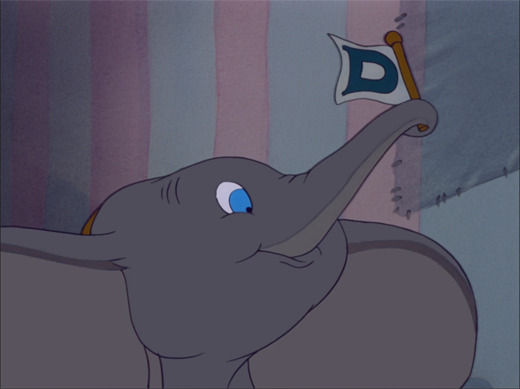
For starters, the film is only 64 minutes in length. This includes the opening credits. From a logistical standpoint, one can understand the purpose. Disney Studios took a financial hit from Pinocchio and Fantasia. They needed something not only profitable, but cheap. The same way that a three-wheeled car saves money on tires.
The story of Dumbo is one of growth and confidence when faced with adversity and doubt. However, the plot is about a young elephant finding an act in a circus. Dumbo tries, and he fails. He tries again, he fails again. Finally, he tries and he succeeds. An entire plot thread seems missing from the film. Dumbo learning to fly (both literally and figuratively) should support a larger narrative.
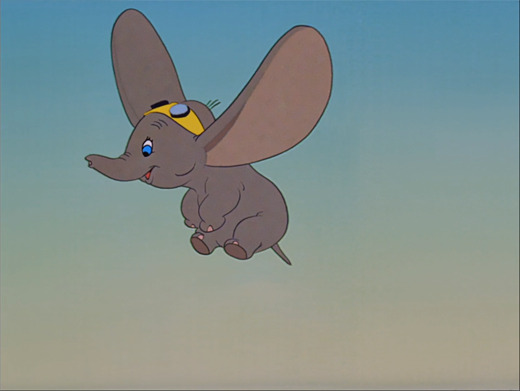
There are no stakes for Dumbo. His failures don’t affect the circus’s income or popularity. Dumbo is ostracized, but still cared for as well as any other animal in the show. He is ridiculed, but still performs every night.
The movie ends before any growth or change is displayed by the secondary characters. Everybody likes Dumbo once he can fly, but do they like him, or do they like his profitability and popularity? If a lion with an extra long tail is born, will he be mocked until he earns respect too?
Everybody in the circus feels comfortable calling him “Dumbo” at the movie’s end. Canonically, his official name is Jumbo Jr, named so by his mother. Everybody calls him Dumbo, a deliberate insult. The name sticks, even for the viewing audience. Either Dumbo begrudgingly accepts this epithet, or reclaims it. Either way, at least his mother should refuse it.
Dumbo’s mother is Mrs Jumbo, a pariah and outcast among the other circus elephants. What causes this exclusion is never explained or hinted at. The other elephants are just jerks. She has no friends, no confidantes, and is apparently widowed; there is never a mention or allusion of a Mr Jumbo. She has nobody in her life. This is presumably why she is so desperate to become a mother at the movie’s inception.
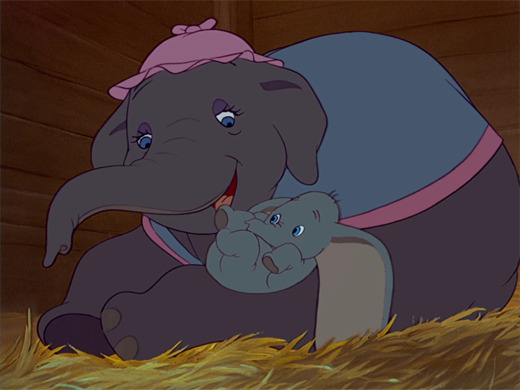
The film begins with a muster of storks delivering babies to various circus animals. It’s a cartoon staple and a very convenient workaround, explaining the miracle of a baby without the depiction of childbirth or implications of procreation. It also justifies how Dumbo is born despite there being no male elephants anywhere in the circus.
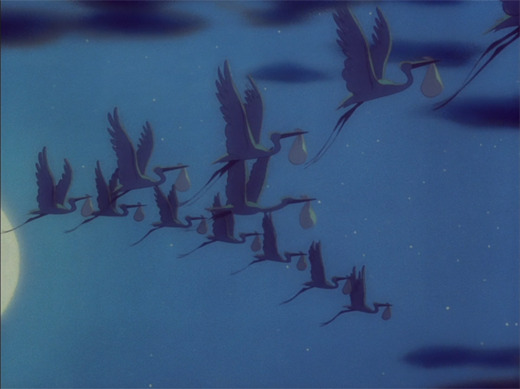
For whatever reason, these storks all deliver their parcels on the same night. All except for Mrs Jumbo’s coveted baby elephant. Baby Dumbo is delivered the following day. After seeing everyone else enjoying their children. After her hopes are dashed. There’s no explanation why the stork arrives late, well after the circus is dismantled and loaded aboard a train. Dumbo is delivered a day late for the sake of drama.
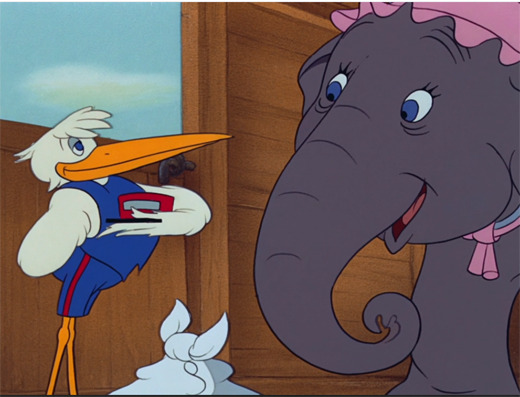
The train itself is almost a character itself. It has a name: Casey Jr. It has a face. It emotes. It speaks. But can he be rightfully called a character? Casey Jr doesn’t interact with other characters. He has no goals or desires besides acting and moving like an ordinary train. It’s an odd design choice, leaving Casey Jr halfway between being a robot and the pathetic fallacy.
Casey Jr is an interpretation of the famed children’s story, The Little Engine That Could. Casey Jr even uses the famous line, “I think I can, I think I can” as he climbs a hill. The story’s most famous interpretation was a 1930s picture book by Watty Piper (a name one could only have in the 1930s). The character and story itself belongs to the public domain.
It wouldn’t surprise me if somebody at Disney Studios tried and failed to make an animated short based on the story. As consolation, they retrofitted the character for a bit part in an unrelated, developing film. The cumbersomely named 'Little Engine That Could' was renamed ‘Casey Jr,’ and a new character is added to Dumbo's universe. A character Dumbo never meets or interacts with, and has no bearing on the plot. If nothing else, he adds five minutes to Dumbo’s anemic runtime.
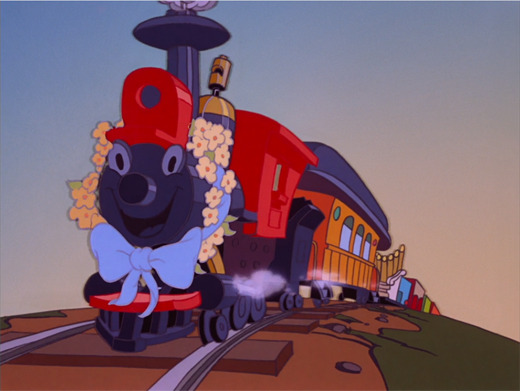
Design is one of Dumbo’s weakest points. Human characters are hyper-stylized caricatures of actual people. Perhaps intentionally, so we empathize more with the comparatively realistic animals. But the animators went too far. The Ringmaster is so rotund, he seems inflated. The clowns have bizarre proportions which are somehow reigned in by their baggy costumes and floppy shoes. The rowdy child who assaults Dumbo looks more like a chimpanzee than a boy.
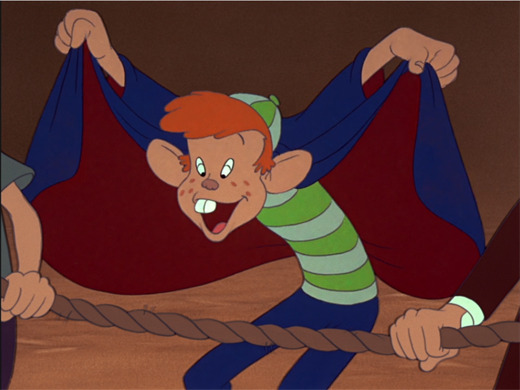
The character of Timothy Q Mouse is perplexing. Is he employed by the circus, or just a circus enthusiast who hangs around the fairgrounds after hours? What would a circus gain from hiring a mouse? Why does he dress like a bandleader? Does this imply an unseen mouse marching band? He never displays any musical ability. He’s there because the movie needs him to be there.
Being Dumbo’s sole friend is Timothy’s secondary purpose. His primary purpose is to outwardly verbalize the thoughts and emotions of Dumbo. Our protagonist is mute throughout the film and most characters avoid talking to Dumbo directly. Without Timothy, Dumbo would stare at camera sadly for the movie’s run.
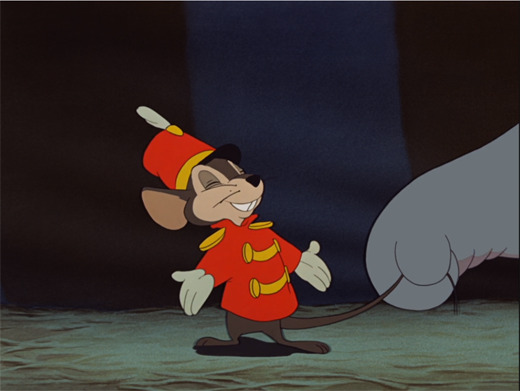
The circus folk themselves are weird, and not just their physical attributes. The Ringmaster is a bombastic Italian man who, as Timothy describes, “never had an idea in his life.” He seems genuine, eager to entertain his audience with an entertaining and original show. His real malice is never workshopping ideas. He will not hesitate to endanger the lives of his employees or animals on his fanciful whims.
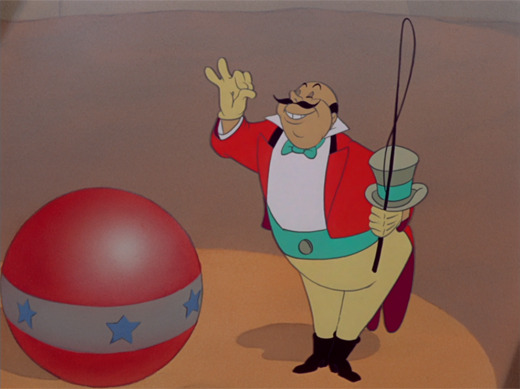
Can six full-grown elephants balance on a rubber ball? Who knows. Let’s put it in the show. Is it safe to have a baby elephant drop twenty feet into a washtub full of shaving cream? We’ll find out. Is it a good idea to start a fire underneath a canvas tent for the sake of a firefighter sketch? The audience likes it, so who cares? Go stand next to the fire, clowns.
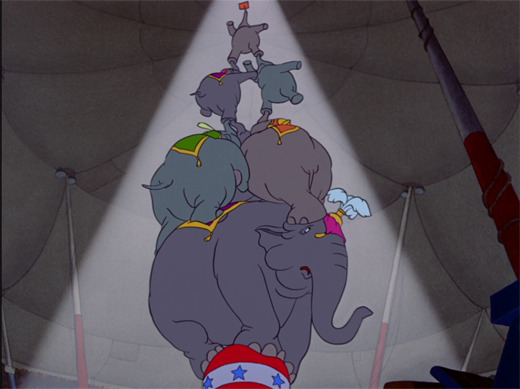
There’s an old adage about doing anything for a laugh, but the clowns from Dumbo take it to a sociopathic extreme. The clowns develop an entire act around humiliating Dumbo. When the skit is a success, they drunkenly decide to put Dumbo in more humiliating situations and more precarious stunts.
It’s implied the clowns are the low men in the circus’s caste; those who cannot perform elsewhere are subjected to the humiliation of clowndom. Does the scorn beget the malice, or did the malice beget the scorn?
Perhaps this is why the clowns are never shown as actual humans. Throughout the movie, they either appear in their grotesque, make-up clad personas, or in various states of undress as silhouettes inside a circus tent. At all times, they are either 100% clown or some spectral figure. They are never seen as human, because there is certainly no humanity to them.
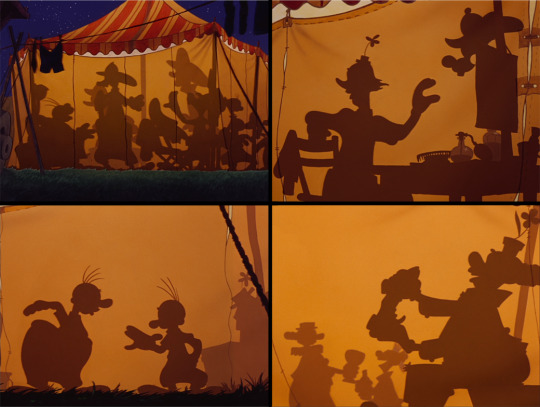
However, the most questionable employees are the laborers. The laborers are not entertainers; they have no face time with any circus patrons. And yet, they are the most important employees of the circus. They are responsible for unloading the train and erecting the many circus structures.
These laborers, tasked with the most arduous and backbreaking of work, are all large black men. As a stylistic choice, they are all depicted faceless. Not even worthy of dignity, they are robbed of any identity and distinguishing characteristics beyond skin color.
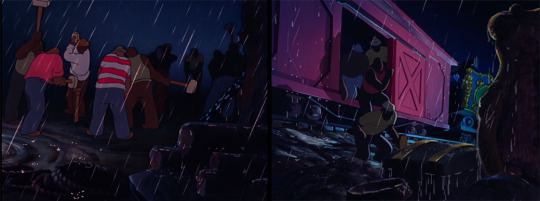
To cushion our objections, the laborers sing about how much they like the work. The song is no comfort. They sing about being illiterate. They sing about being underpaid, and routinely subject to wage theft. They sing about how its their very nature to be irresponsible with money. They literally use the word “slave,” and “ape” to describe their circumstances. Thank you, 1940s.
The only other black characters are a murder of crows introduced in act three. These crows must be less racist in depiction and demeanor than the laborers, right? They couldn't possibly be worse, right? Then one learns the leader of the avian posse was named “Jim Crow” on all Disney material until the 1960s.
The entire Civil Rights Movement needed to happen, but somebody eventually realized a children’s cartoon character named after the most provocative blackface character in history, the namesake of the American laws that enforced segregation, was a bad idea. It didn’t help Jim was voiced by a white actor. Cliff Edwards voiced Jim Crow (later renamed Dandy Crow), the same actor also voiced Jiminy Cricket in Pinocchio. Jiminy Cricket has appeared regularly as a beloved figure in Disney merchandise and material. Dandy Crow has not.
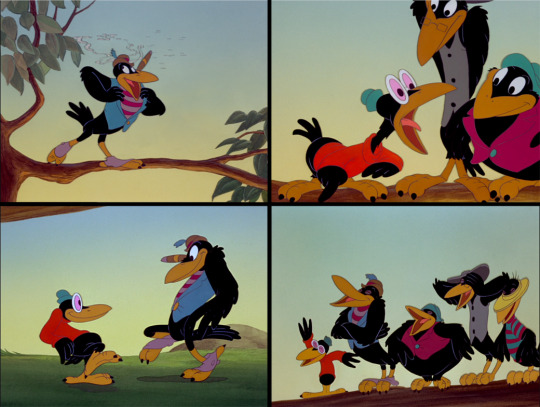
To Disney’s credit, the other crows were voiced by actual black actors. Although, one has to wonder if the AAVE was written into the screenplay, or if the director asked the actors to create it on the spot. There’s no good answer.
The crows’ musical number was performed by the all-black Hall Johnson Choir (with the exception of Edwards’s vocals). Their number, When I See an Elephant Fly, is one of the better pieces of music in the Disney catalog. It's full of jazz scatting and clever wordplay. It’s a shame its existence is marred by its racially charged source.
How an oversized pair of ears grants the ability to fly is not important. It’s a cartoon. The ears are a means to an end: the physical feature that made Dumbo a laughingstock also granted him a most unique ability. Differences make us strong. It’s a good moral (even if the film is hypocritical).
The depiction of the moral’s resolution, however, raises eyebrows. Upon discovering he has the ability to fly, Dumbo seizes the opportunity to take revenge on those who wronged him. He circles around the big top, swooping at the ringmaster, scaring the clowns, shooting peanuts at the other elephants like bullets from a machine gun. ‘Make your enemies pay,’ is the takeaway. Suffer all, enemies of Dumbo.
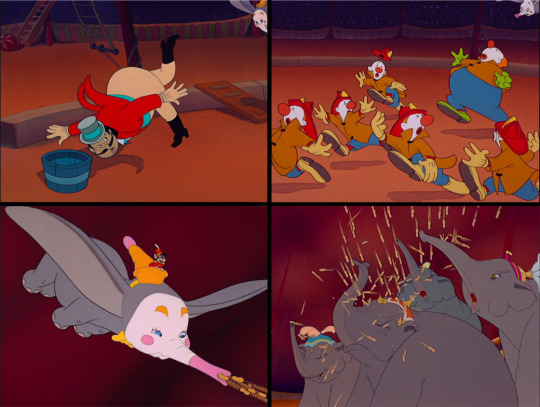
Some may argue Dumbo’s character arc is not redemption for himself, but for his mother. Mrs Jumbo spanks a young boy who assaults her infant son. The circus folk misinterpret this act as a rampage. She’s is subsequently shackled and imprisoned for the forseeable future.
Even after being deemed hazardous and mad, Mrs Jumbo is never sent away. There is no indication of punishment beyond isolation (why the circus keeps a dangerous rampaging elephant on circus grounds is a creative liberty). The true punishment is being separated from her son.
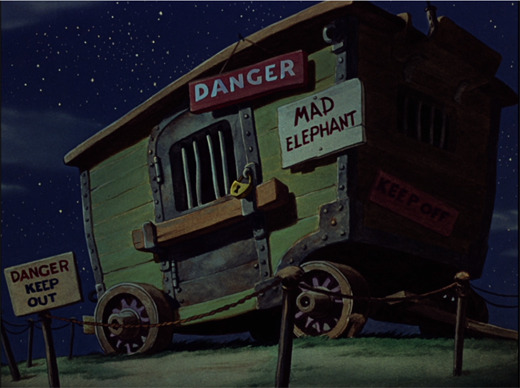
The movie ends with Dumbo as the star of the show. Everyone sings his praises, he has his own personal train car, and Mrs Jumbo is freed. The question is, why is Mrs Jumbo freed? Just because Dumbo is beloved, why is Mrs Jumbo’s perception as a threat forgotten? Why is she forgiven because her son is popular? Dumbo cannot speak, how can he serve as a character witness? Why does Dumbo's achievement redeem his mother's actions? The writers delivered a happy ending by solving a problem that was never actually solved.
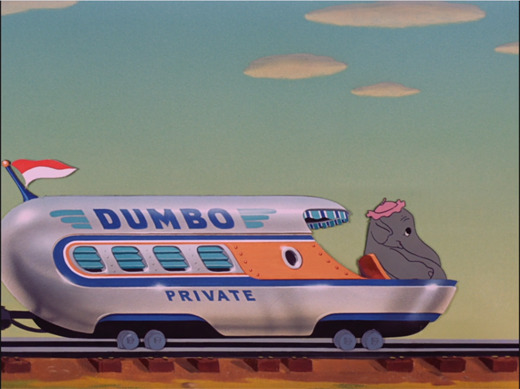
Dumbo is a film full of illogical scenes and developments. It's grandfathered into the cultural pantheon despite outdated imagery and storytelling. It has good intentions, utilizing themes of overcoming adversity, the endurance of familial love, and appreciating each other's differences. But these good intentions are drowned in too many narrative shortcuts and a sloppy execution. It’s a pleasant movie the less you remember, and most people’s memories are hazy. What’s more appropriate from a film whose most famous scene is a surreal drunken musical hallucination?
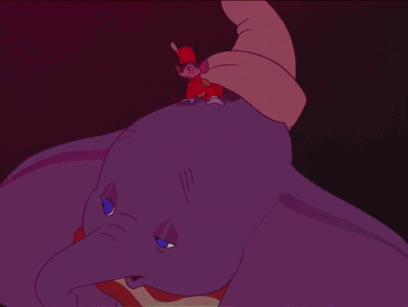
Fantasia Snow White and the Seven Dwarfs Pinocchio Dumbo
#Dumbo#Disney#walt disney#Walt Disney Animation Studios#Film Criticism#film analysis#review#Disney Canon
9 notes
·
View notes
Text
Archenemies - Part I
Disclaimer: partially inspired by Supercorp and the very enjoyable facets of their dynamic. Hope you enjoy.
Commotions are always a good indicator of such happenings.
The first eyes on the scene are of course those of curious and surprised bystanders. Rarely does such an event be broadcast in advance. It's happened before, of course. Only a handful of times, however. It means the evildoers are confident in their plan and seek attention, two very bad news for any respectable super. The last time it's been the case, panic managed to erupt, only quelled by the competent authorities with some effort. Some joker tried to replicate the one before last, he's apprehended after barely an hour of shenanigans and threats, each more unbelievable than the last. What he tried to emulate, however, remains scarred deep in the minds of many. Blood and ashes flowing on the grass of the Magnus Arena in the city center on a crisp summer day, and the center itself drowned in cries of pain and terror. On that tragic day, SkullB makes the decision to invest in the services of both Mister Mind and LaValette, two of the most intelligent and cunning cons out there. One hundred and eighty six people die, each one in a slow and far too well documented way. Three pros are amongst them; experienced supers, yet they fall prey to SkullB's devious plans. Dame Seven, Verustoski, husband and wife in the business since the late 70s, and Sunny Sin, a young yet very capable teenage wiz, give their lives in exchange for SkullB's.
Mind and LaValette are, of course, smart enough to see themselves out once it turns in their disfavour, almost as if they see it coming. The former is caught a few days later, splurging on an online casino in his own underground mansion, while the latter still eludes the authorities to this day, taunting both pros and cons in an odd twist of fate. They realize the whole affair is getting far too out of hand, and some even speculate one of them (or both) to consort with the authorities to create the distraction that allows to bring out most of the hostages and to take down SkullB. That stems from irregularities in the chronology of the event and the fact that LaValette apparently decides to own up to her actions after that day. Not completely mind you, but enough to make a difference with a surprisingly efficient foil to many a plan, good or bad. Over the next few years it's apparent she's taken upon herself to remove supers altogether. Not in a definitively violent way, shockingly, but using her agile mind to dismantle actions undertaken to a significant risk to the city and its people. Dynopolis grows less weary and more peaceful due to that. It lasts a sufficient while for her to gain a strange and ambivalent status of anti-hero - chaotic good, as many surmise, in similar leagues to that of the legendary Crime Man himself, some add.
That changes over time as more and more supers, heroes and villains alike, manage either in their smarts, numbers, or luck, to pull and tug at the seams and reveal the cracks in her masterplan. What it loses in her ability, however, the city gains in balance. Many new pro upstarts join the ranks of a newly reformed agency, trying to attain both glory and riches, and to "do the people of this city some good". It's obviously been mirrored by the rise in organized and supercharged crime. That tendency is there from the beginning, structured even before the pros are themselves. It naturally evolves with the times and the influence of one changes the other. Not that they necessarily know - she doesn't care much for one or the other - but she naturally leans into that tendency. If one wants to make a difference by playing the game, one has to remove themself sufficiently from the board, and that she does in a surreptitiously efficient manner.
The second factor which sees to an apparent decline in her efficiency had been more subtle and more specific (although she would argue that it's not so much a decline rather than a shift of focus). It baffles a number and is the joyous guilty pleasure of some others, more observant or perhaps more versed in theorizing. It's fairly unnoticeable at first, by the audience as well as by those involved. The powerful blonde enters the scene unnamed and unknown, and almost by coincidence - officially "on a whim". A small incident takes place in the southern branch of Nat·Bank, devolving into a chaotic chase over land and sea. A simple passerby at the time, the greenhorn not-hero (yet) jumps to action, pursuing the robbers onto the beach and into the coastal waters once they reach their means of escape. Perhaps it's her gallant effort in taking them down despite their ion guns and reinforced armours, bringing the boat back to shore single handedly. Quite literally at that: she emerges on the warm sand pulling the swift vessel behind her, dragging it to the middle of the beach for the authorities to arrest the now baffled culprits. Many onlookers capture and immortalize this moment, making her drenched fit form into an object of many speculations for weeks to come. Her identity somehow remains unknown behind a hasty yet well-placed mask of cloth and nothing is made of it despite extensive research and avid requests on all fronts.
...
Dantra reveals herself almost two months later, to the day, new protegee of sorceress Saralis and a fresh recruit of the H.E.R.O. program - revamped by a retired Dynaman and funded by the Ministry of Defense to raise and promote fresh blood to the side of justice. She's expected to tour the studios and is breathed to be the new mascot of the agency; yet, despite all her efficiency and achievements on the field, she remains as elusive as on the day of her appearance on the chaotic stage. Her speculated concealed beauty adds to her engaging demeanor during her interventions, on top of her flashy yet efficient use of her power. Her flawless track record, only highlighted by her immediate appeal following her first and only late night show appearance, made her an almost instantaneous star, rising fast into the pantheon of revered supers. Some wait for her eventual demise, criticizing her close interactions with fans during downtime and her refusal at revealing too much about herself, theorizing many reasons, each stranger and more somber than the last. Yet it does not happen. She assimilates into the lifestyle flawlessly and durably, it seems. Perhaps too flawlessly for some. Not exactly dwindling, her popularity somewhat reaches a peak over the first year and a half during which she becomes active.
If she's anything, Dantra is not discontent. She takes it in stride, making the most of her situation, to the greatest pleasure of her enduring fans. If she's to plummet, she will, not that it will stop her from doing what was right as long as she was able to. Or so she tells the young reporter who manages to get the first interview in months. And she does, standing as a proud beacon of righteousness and letting life take its course as she does all that is possible to protect and help. This despite the insistence by the agency that she capitalize on her success. She does not yield, however, and accepts that interview on their recommendation only to clear some misconceptions that seem to have arisen over time. No she does not wear a cape and does not plan to as it would hinder her movements. Yes, that piece of white cloth she wears over her face is a replica of the original one, it's been retailored and enchanted by Saralis herself to not be easily removed. Oh she doesn't know if one could say 'superstar', she is proud to make a difference however. Definitely M'Persent, she's been amazed at their display of precision in the way they used their telekinetic powers, since her youngest age. That's excluding Saralis, of course! *laugh* Boreastre, perhaps, on one of his bad days and on her good, then again she has to respect the old man's resilience so, who knew… he is the only con to ever elude the great Dame Seven in his hayday, so that has to count for something. None of the above; the money is enough, the benefits are great, and the ability to use her powers as she does is compensation enough. Because it's right, that's why, and perhaps also a bit in honor of her grandfather, a war hero who she's always admired. Oh…! Uh, yeah, many. So many. Too many. *laugh* But no, never, actually. Sadly. She never has the time or the space, she guesses, or perhaps she's not been looking well enough. One day, perhaps, in her old age, in one of those quiet suburbs, with a dog and a small garden with flowers… That's a new one, never been asked that before, yeah, uhm, if she had to say, perhaps no sea, not that she doesn't like it, she loves the sea, but forests always seem more beautiful, intriguing, and without any tree how is anyone to breathe? *laugh* No, thank you for inviting me, it was great! Oh, yeah! Uh, stay safe and do good, folks. Until next time. *wink*
Some questions she does not answer or shifts the subject, but all in good sport. The interviewer doesn't seem too annoyed by it, more understanding than anything. They're even genuinely excited when she offers a quick demonstration, squealing when she does her trick with the water. Neither do the executives at the agency, they even congratulate her on its good value. She feels good after that, can't say no to fun. She returns to her usual routine without barely missing a beat, if only slightly more discreetly, satisfied for days and unwilling to engage in too much outgoingness at once. That seems to be her prefered rhythm: appearing sparsely on occasions unrelated to crime fighting yet always with panashe and with good reason. Time passes and finally she knows: her secret is safe. Tucked away behind the thin layers of her mask and her gentle charm. There are a number of reasons why Dantra refuses to unveil too much of herself, be it to her fans, enemies, or even her colleagues. She is young but has enough knowledge of the ways of the world, especially online, to wish to be careful about what she exposes of herself. She enjoys the attention yet wants nothing of it once the mask is down, relishing the quiet moments in her cozy house near the waterfront and the edge of the city. The most important reason, the vital one, is not because of a loved one - she's been alone for as long as she could remember - nor because of her job - the agency pays well enough, and a side gig as a commission photographer allows her to pass the time. No, her deepest, darkest secret is entirely other: she does not trust herself to look quite right, to pass well enough among them. She never has. Not before, nor since her arrival and her… change of style. Her face has always felt too angular, too sharp and harsh, underlying the softness that sugar-coats it. Okay, maybe it is stupid to hide such a thing, what with aliens and wizards and so many kinds of secret and supernatural entities buzzing about. Especially considering she is in fact time-displaced herself. But she's a private person and her doubts never quite leave her, neither with nor without the mask. Especially not without. And that's something she wants to keep to herself as long as possible, if not mostly because it would show the cracks in her heroic persona.
One second she's living her perfectly normal if only slightly different life in the wilderness, and the next she finds herself surrounded by stone and metal and sound. So much noise. She fled the great fortified city of her birth for that exact reason, the smells and bustling activity making her prefer the quiet of nature. It's scary, so very scary, at first. Frustrating too, new words to assimilate, new people to remember. Many people. Too many. Tastes and colours as vibrant and foreign as they were interesting. It should be more difficult, more off-putting, it should be a lot weirder and far slower to adapt to this new life that she's quite literally thrown into. She knows that. But somehow, either she's better at adapting than she believes, or the strange shrieking and smelly hole she's been dragged through - she later learns it's all that ozone - has been kind enough to gift her with an augmentation in her abilities. She can't say. Assimilating information has always been easy for her, computing it, on the other hand, takes a bit more time, but she manages well enough and that's a start.
No one knows any of that, not the agency, not her colleagues, not even her best friend Zelda knew of it, and if she has any say in the matter, none would ever know.
…
Later on she realizes their first meeting is not their first. It's not even the first time they actually interact, simply exchanging a look as she disappears into her surroundings while the hero goes the other way in hot pursuit of her own target. They cross paths before, at least twice, always en passant and never out in the open, none recognizing the other. How Valerie Vonazzio misses and is missed so thoroughly becomes one of the many subjects of scoffs and giggles, somehow playing the absolute opposite of their actual first interaction.
How it goes from a simple meddling in a high stakes robbery to a double hostage situation with innocent people in the crossfire she would say is entirely the annoyingly boot-straight bulldozer of a newcomer's fault. He's the one who barges into her delicately masterminded play's fault. They simply have to open the safe, take the money - in truth a pile of fake yet highly realistic 'the artist formerly known as Prince' bills she planted there earlier - and attempt a getaway. No violence needed, no casualties, and she can pocket the money for herself. Not that those to whom it belongs would miss it, even if the amount were to be doubled. And everything seems to work perfectly at first, that is until that idiot of a C-list super Faramour and his disgustingly felty suit gets stuck in one of her countermeasures and calls for backup. The channels should be jammed, they are jammed, and yet, somehow, she hears. Dantra enters all guns blazing - not literally though, she bears no weapons. Praised be that fact or things would go downhill much earlier for the great LaValette. She has no guns, none made of metal at least. It does not prevent her from bursting in, plowing half the group against the wall and intimidating the others sufficiently for them to lose their cool. Having taken two hostages, threatening to do some actual damage if 'superblondie' refuses to cooperate. She doesn't, to Valerie's relief, but she's the smarter of the two, after all. By far. Faramour, on the other hand, does not do the smart thing. Barely liberated from his restraints, he takes one of the robbers in return and immediately escalates the situation. How it hasn't gone to shit quicker with that horrid perfume of his, Valerie will never understand. Deadly weapons are pointed in every direction and a single movement might set the whole thing on fire.
That minty, hair-waxed bumblefuck of a super doesn't even try to use his lonely brain cell, it seems, choosing to ignore Dantra's warnings AND the robbers' threats, yelling louder than either for everybody to shut up, get on the ground and put their weapons down. Despite the fun she'd had recording his disheveled meltdown and against all her principles, she intervenes then. Showing herself in broad daylight for the first time in months, perhaps years. Well, as best as one can through a thick field of smoke and behind a specialized retailored special ops suit. While they're all distracted, she takes Faramour out, stunning him into oblivion and then twice more for good measure with simple yet efficient darts of a sleep agent of her own personal concoction. The robbers are easy too: make them think they have a way out and leave the appeal of the money, and the next second they're running. Dantra is another story. She thinks of lacing the smoke with a sleeping agent but doesn't want to hurt innocent bystanders - she has principles, or at least she's tried to grow some - and instead deploys a simple spot-sonic. The small device works as a grenade and is used to stun anybody of above average physique - group which she instantly guesses Dantra is a part of - and gives her an opening of a few seconds to make a getaway. Hers has been ready for hours now, but as she rounds the building and her car she hears the voice behind her, ordering her to stop.
Dantra is coming around the corner too, armed with a surprising two unconscious robbers, one in each hand. Fortunately she's decided to go stealthy this time, wearing unmarked gear and a simple black gas mask. The lack of recognition she gets from the super means that either she does not know her face, which for the agency's poster girl is highly unlikely as the agency must have drilled her on the many cons they were tracking, LaValette still being high priority. Or that she has no way of seeing through her mask, past her eyes, which is lucky as it has definitely not been designed with x-ray vision in mind. She looks at the blonde for a second too long, perhaps, and her mind is made: she has to play this one well.
"Why? You gonna arrest me?"
"As a matter of fact no, but the police will once they get here."
"Ha. Apologies darlin', I have no time to wait for them. Things to do, places to be," she replies, her tone as cocky as possible.
"You have nowhere to go. I'll catch you if you try to run…"
"Maybe. But I don't intend to run," she jiggles the keys in her hands.
She sees the frown form on Dantra's face through the cloth, a cute set of lines creasing around and above her brow. The super lets the robbers fall to the ground and takes a step forward, then another. Good, just a few more seconds.
"I'm fast."
"Strong too, I guess."
That stops her.
"You're too confident."
"Mayhaps. But so are you, I believe."
"I have the means to back my words up, do you?"
If the very slight flex of her hands and her taut muscles is any indication, the hero does indeed, and she's ready to show it at any moment. Perfect.
"I don't doubt that. But see," and she takes a small step to the left, Dantra mirrors it to the right, "my ride is waiting and they don't have a policy of canceling last minute, so I'm afraid I won't be able to take you up on that."
"The choice isn't really offered."
"It is though, and I'm certainly not letting a muscle-brained blondie tell me what to do."
That gets her a frown. Good. Let her stew a bit.
"You're not part of them."
Oh, surprising. Not all brawns, then.
"You noticed."
"I'm more than just muscles."
"I can appreciate that."
And she winks for good measure. The slight abashed surprise which momentarily coats the frown is worth it.
"You'll be happy to know I'm not all ass either, darlin'."
And with the image of a vague incomprehension mixed with outrage, she presses the ignition button. The car beside her roars to life and then everything is gone, swallowed in the bright neon light of the headlights and the piercing shriek of the alarm. That's enough to make Dantra recoil; by the time the super focuses again, she's long gone. Not very far away, but out of reach.
…
The second time they cross paths it's more official and perhaps she isn't as prepared for it as she's like to make them all think. There's a joint operation by the newly formed Hexagon, a trio of wrongdoers comprised of Miss Spell, Shore Thing, and Sasz, who apparently decide to carry out plans as horrid as their individual designation. How people, supers mostly, come up with such ridiculous names for themselves is something she'll never quite understand. It does help motivate her to foil their plan without pulling any punches, however. Which is a good thing, she thinks. They try to steal one of the prototypes in development at Atomic Delaware Industries, some sort of energy cell that could either be sold to competitors or foreign powers for quite a pile of cash, or be used in not so nice ways by someone smart enough. She certainly would find a few uses for it, she has, actually, without trying too much, even. But that's not the plan, it hasn't been for quite a while. They've been on her radar for the last month and, unfortunately for them, a whole month is entirely superfluous if one were to want to rig the whole operation. Which she does.
The traps fly and spring, doors jam, electric circuits fry and, strangely, the alarm resounds the minute they're deep in the vault despite all their attempts at quelling its shrill signal to the whole of the city police force before they break in. The panic but not so much as would other newer and less competent cons. The prototype is loaded in a rush as they manage to evade the first wave of security. It's jostles a bit - quite a bit - as they come out into the night. Whether it'll still work after that is anyone's guess, although she has an inkling as to the answer. It's but almost entirely confirmed when the crack resounds a few meters in front of them and Dantra appears, making them drop the cart onto the ground and letting the round object roll away. The trio tenses slightly, knowing they have the advantage, but Dantra shows no sign of faltering. The fight that ensues is what makes Valerie act upon her growing frustration: had she let them exit the perimeter they'd have been caught in her electromagnetic web until the police arrived. But of course the hero has to meddle in her affairs. She almost doesn't swarm all four of them with slime ice, a new project she's been working on for a while, trapping anything it touches almost instantaneously (super or not) and with enough efficacy it would work on Dynamos and his high speed vibrating or Saralis and her plane shifting. At least long enough for her to escape. Almost, because as she's about to think better of it, something barely misses the prototype. It's either a hex or an exploding scale, she can't really tell, but she knows that if it hits, they might not be there to argue whodunnit afterwards. To hell with being subtle, she doesn't want to die yet, and there are people in danger of being fried by the foursome's stupidity.
"Oy, nitwits!", she exclaims, stepping out of the dark black sedan she'd taken shop in.
They seem surprised to see her, enough to almost all freeze on the spot. Only Sasz seems not to lose any of his countenance - his cerebral implant must help, she thinks - which is a good thing because they don't immediately notice the small flattened cones that thud in the middle of them.
"What the fu-", she can hear Miss Spell attempt.
"Stop clonking so close to the prototype. Or do you want to raze this whole area to below sea level?!", she adds, seeing Dantra's eyes narrow.
"LaValette," Sasz simply says, still unperturbed. Not that he seems quite anything in the recent months since his upgrade. "How very pleasant." Well at least he's kept his tongue.
Miss Spell opens her mouth again but stays silent, still she can see her violet eyes widen slightly; Shore Thing doesn't react, simply getting ready to fight her too. She sees the flicker of recognition on Dantra's face, however. She wonders for an instant if she should have worn a mask but finds she is almost glad - a small prickle of pride even runs through her spine at the validation of her still very-well known status.
"Stop where you are," she hears the blonde's voice command.
"Oh don't worry, I don't plan on joining in the fight," she smirks, "I'm not made for that."
She lets a beat pass and sees them stew in their uncertainty. No more than a beat, however, or they'll have time to react.
"Plus I don't need to," her smirk widdens as she nods to the ground at their feet.
They look. Sasz and Dantra are the first to react but it's still too late. The cones explode into a storm of white and suddenly all four of them are covered in a thick layer of foamy substance. She has to give props to Dantra for attempting to jump away, but the slime ice hardens too quickly and she's frozen on one foot, her body angled back. They almost instantly begin to slump too, even Shore Thing's weird biology doesn't stop him from feeling the effects of the sedative. It won't take them out, she knows it, but it'll do for a while. She can already hear Miss Spell mumble curses under her breath, it would be cute if it weren't literal curses on top of her insults. She hurries her step, not wanting to overextend her advantage.
"Not that I don't find this fun but I can't trust you people with this," she grabs the prototype, "so I'll be removing your new toy from the playground until you learn how to share properly."
Without further ado she walks back to her car.
"Wait," she hears Dantra's slurred voice.
But she doesn't no matter the slight desire to play with them a bit longer. She knows if she does she'll lose her advantage quickly.
"Sorry darlin', can't stay. Have a nice night!", she smiles as she passes by them before rolling her window up and driving away.
Her exit goes unchallenged, none of the police notice the black vehicule hidden behind the bushes as they quickly drive by a few seconds later. The next day she confirms her slime ice was indeed efficient, more than she had banked on even, as she sees Sasz and Shore Thing still partially trapped in by the time the news channels are on the scene. Apparently Miss Spell managed to phase herself away in the nick of time, escaping right as the authorities arrived, Dantra taking only a few moments longer. She can't help the amused smile at the sight of the fit blonde going away as quickly as she can once the situation has been explained to the police, surely in search of her. The super doesn't succeed of course, as her being in her penthouse at that precise moment indicates. The morning is nice, warm with blue skies. She contemplates letting Dynopolis and its officials sweat it a few days more under the threat of her possessing the prototype, but decides against it. She's a tease, not an actual madwoman. The stolen property is found two days later in Hubway Park, in a glass box with a cute little ribbon on top of it and a card that says "Love, LV" in elegant cursive. And if the city's pockets are slightly lighter after that, well, it's not her secret to tell.
...
They meet again twice before it truly becomes a sort of routine between them. Not that she actively makes it that way. It just seems they can't stop themselves from running into each other. Maybe it's because LaValette's officially made an appearance after all this time, in front of no less than four supers, three of them being cons is of no consequence. Maybe she can't quite stop herself from being on high alert every time she goes on patrol, looking for the lithe dark woman in every corner each time she's called onto a scene or she is made aware of some nefarious happenings. The fact that Dantra is seen a lot more than usual out there does not go by unnoticed and many speculate as to why. The answer is simple: she's been bested thrice and she can't quite let it go. The smirk and the confidently teasing tone of a superior mind still ring in her ears. She's never been one to be very competitive, not seriously so to the point of letting it consume her rather laidback nature. But the villain has a way of getting under her skin. The con times her quips like the beats of a good song, like strums of chords during a guitar solo, settles her silver eyes so steadily that she can't help the shiver of anticipation at the challenge she knows is coming. The first time it's just a fluke, she doesn't realize she's facing the great LaValette herself, not even that she 's in the same realm as her for a while. The second time she gets the message but slightly too late. The result is positive in the end, not satisfactory however. It does have the unintended effect of giving her a purpose. She knows she can't force destiny, doesn't quite believe in it either, but it feels like something the third time they meet. She wants to be there because she knows what's coming. Or at least she knows LaValette will grace them with her presence. She loses her after a frustratingly slow chase amongst corridors and stairs in the tall building where the villain comes to meddle with an intervention the squad puts in place to nip the bud of a growing cult.
The thing doesn't go as well as planned. The cult is too prepared, as if they know what's coming. They manage to get them taken down before any blood is shed, however, which is a good thing. Until she realizes the ease with which it has been done and the glaring disappearance of a number of useless but golden artifacts the cultists had been in the process of using for their sacrifice. She realizes immediately what's afoot, perhaps a bit too quickly if she trusts the bewildered looks she gets from her partners. She spots the suit far too quickly too. She's nothing if not thorough and she's made her research on the older villain turned chaotic vigilante. Her style has changed slightly, moving on from spandex and leather to a more comfortable fabric oriented design. Still black, still badass and cool - she can't help but admire - and still kicking ass without actually doing any of the kicking herself. But as she's about to reach her, LaValette lets her know she's noticed her with a small turn of the head and a wink as she moves to the staircase. The resulting chase happens in a place too constricting for her, which she hates, and amongst a crowd of people who have no business being as productive as they are on a Monday. Still she follows as best as she can, careful not to damage anything. Unfortunately it's not enough and she knows it when the villain slips away one last time, dropping in an elevator shaft this time, and she's unable to follow. Not that she'd fear the fall or hurting herself (her body can withstand much more and quite literally fly, after all) but because she realizes she's been tricked when the shaft turns out to be a screen and she finds herself flailing not to walk off the seventeenth story. How the frustratingly smart woman managed to do that she doesn't know but she knows she's lost her. Despite it all, and while she does a round of the floor just to be sure, she can't help but be impressed. LaValette has never shown any other sign of outstanding abilities than her impressive intellect and for once she's glad it's the case, just imagining that coupled with any supernatural ability almost makes her shiver.
Their fourth meeting is the one in which she feels her work finally begin to pay off. She's been scouring every file, report and analysis she can find, all the footage available for clues as to what counter-measures she could try to put in place against LaValette for weeks. The incident at Magnus Arena makes her both angry, wanting to catch the woman as soon as possible and make her answer for her crimes, but also realize how much the villain has actually shifted her line of conduct since then. She doesn't quite know how others have not measured the impact of her actions since then, both to annoy supers of the program and to mitigate the destructive power of cons. There's no proof, no evidence, but she can read between the lines, feel the depression in the landscape of her crimes, and see the shadow the villain leaves behind her in each misdeed that goes a little bit too smoothly for the heroes or which seems to fail or combust in the air for the cons. How nobody has never noticed that is beyond her. Perhaps the long arms of LaValette extend even within the agency? Or perhaps someone else has been trying to keep the status quo?
It's a bit of a paradox. She gains newfound respect for the woman but at the same time the neverending list of accomplishments - which she seems to silently gloat about every time - makes her blood boil and gives her renewed determination to catch her.
So when she manages to corner her in the back alley of the store as she's about to flee on an unmarked bike, and she sees the brow quirk up in surprise as she halts mid climb, well she can't help herself and smirks.
"Well good evening to you," LaValette says, resuming her action and strapping the large duffel bag containing various pricy items to her bike, pricy items that the organized but not very professional group of masked individuals attempted to rob - are robbing? have robbed? - and will realize are missing from their own possession the next day.
"I would return the greeting but you're coming with me this time, and it will unfortunately not be 'good'," she quips back, hand on her hip.
LaValette has been calmly setting up her gear, putting on a pair of gloves and a scarf, zipping up her jacket, action following which she seemed to notice the quick glance, her smile widening ever so slightly.
"Not that the offer is not tempting, I'd love to stay but-"
"Stuff to do, places to be?", she cuts in.
The villain smiles wider still, a mischievous glint in her eye.
"Exactly."
"Well, sorry to burst your bubble but I can't let you do that. You being a criminal and me being a hero, and all."
That earns her a chuckle. There's a pause, the woman makes a grab for her helmet, still showing no sign of a rush or any kind of panic at all. This is what makes Dantra start to question her standing in this exchange. She has a way of getting her nerves to flare. It seems the woman notices, her head shifts slightly to the side. Could she read minds? Or was she just that smart? Dantra realizes she might just be that smart
"Oh I know. And I can assure you I'm very flattered by your attention, but should you really be leaving those idiots alone?"
She follows the finger, it points at the store and suddenly, as if on cue she hears an explosion and sees bright flames erupt from the roof. The door she'd passed through moments earlier flies off its hinges and crashes against her, denting itself around her shape.
"What the-" she begins when she hears the engine rev.
Suddenly she's jumping to action, she lets her flight boom her through the alley and can feel the fleeing motorcycle revving its gears enter the grasp of her outstretched hand. Yet before she can do anything she hears a bump and her legs are once again cast in that annoying white substance, not only does it harden, it also latches onto the ground and she's faceplanting before she knows it. That much isn't enough to slow her down too much, and she's up the next second, grunting as she breaks through the foam - the countermeasure is one of raw power but it works, so, who's to judge. But as she's about to engage in pursuit again, masked individuals come pouring through the now destroyed exit and for a moment she's stunned. Why weren't they- It's then that she hears the shrill voice she's learned to dislike with every fiber of her body. Freaking Faramour…!
Only later, as they've rounded up the criminals that tried their best to escape and the police are there to take them into custody does she register the memory. It's seemingly jogged by none other than the felty cretin himself.
"Nice work, blondie!", he exclaims with a thumbs up.
Perhaps it's genuine, perhaps it's just playing it up for the cameras, she doesn't know, doesn't care much for it either. She's let her target escape once again. By the time she'd taken care of the robbers, barely a minute, and was soaring in the sky to try to locate the motorcycle, it had vanished once again. The criminals had given her restraints - a good measure of fence wire - a run for its money, already almost escaping by the time she came back down and she'd had to secure them once more. Then she'd taken measure of the whole situation: a blown up store, a bumbling super idiot trying to take over the situation and a disappeared LaValette. Then the police arrive, then the journalists, almost in sync. Then there's the report, which Faramour takes into stride despite his less than useful participation, and nobody seems to have noticed LaValette's presence. She'd been this close, so close… She tries to wallow a bit in her corner but even that is made difficult when Faramour comes all smiles to congratulate her. She had to at least nod and smile, she may be one of the most prominent faces of the agency - and miles more efficient than him - he had anteriority and some form of mind-boggling respect in the city. But his words trigger the flash of memory.
"Nice try, blondie!"
Almost the same words but a much, much different tone. Sultry and smooth, teasing as usual. With a smile and a wave of the hand as she rounded the corner, spoken in a voice loud enough for her to hear. The frustration is so much that she almost lets out a huff before she takes off to do her report at headquarters. It's only when she's done and gone home that she realizes she was close, much closer than usual. Next time. Definitely next time.
And next time comes. Much sooner than she'd expected. Barely a week later, in the middle of the afternoon. This time it's utter chaos. Three events strike at the same time. Havenleaf institute, the prison that houses many cons, is taken by Miss Spell and what can only be described as strawmen goons which she surel animated. Apparently an attempt to break out Shore Thing and Sasz. Nat·Bank is in the middle of a robbery orchestrated by the BronzeBronze cartel. And the head office of the Police is being hacked. The bank and the prison are already taken care of, Grace Solace and Mesmeride are on the case with their respective sidekicks she hears in the coms, and the police should be able to deal with whatever genius has decided to try his hand. She's met the ITeam and they know what they're doing. Still, she can't help but feel something is off. The coincidence is great, almost too great. So she goes anyway.
Everything is hectic. Power is going out repeatedly, the whole electrical infrastructure seems to be under attack. Which is weird, Rajan and Sam explain. They've made sure the whole network was secure and entirely closed off. She knows it is, she's seen Sasz try his hand at it and groaning in frustration. So whatever whoever is here wants, it's not in the database. The chaos feels too orchestrated. Like a danger looming around the corner and forcing you into panic mode but never making an appearance. She knows this feeling and that's what propels her into the stairs, down to the third basement and the writ archives. She struggles in the dark silence for a while, only nearly jumping when she hears clattering towards the deep end. The ever-knowing smile that usually welcomes her is only ever so slightly assured this time, only ever so slightly weaker, and she knows she's struck a chord.
"Wasn't expecting you so soon, darlin'", the voice drawls as the woman has the gal to look away, back to the files she's been searching through.
"Were you even expecting me?"
Her tone is light but it seems to land once again, from the slight tensing of the shoulders.
"Honestly? Not really. I hoped to have at least an hour uninterrupted, but it seems I got unlucky…"
She can't help the small satisfied scoff. She can't help the spark of curiosity either.
"What are you looking for, LaValette?"
The dark woman looks up, surprise passing through her steel eyes.
"Nothing much. Compromising pictures from college, maybe?", she chuckles. "What tipped your off, Dantra?", she returns.
Dantra knows she's curious but fakes disinterest. Somehow she knows. So she plays on it. She also can't help but lose some focus to the way her name rolls out of LaValette's mouth, soft and playful.
"I got lucky I guess. I had a hunch."
"A hunch?", a quirk of the eyebrow.
Now she was looking at her.
"Three at a time is a bit much."
"Ah," a shake of the head. "Maybe so… might have been a bit over enthusiastic on this one."
"You made all this happen?"
She should know better, she's seen the famed LaValette at work more than once, read and watched everything there was about her, but she still feels the wave of surprise at the revelation.
"No, I'm not omnipotent, you know. I may have… pushed the right buttons, however."
The smirk is back.
"Well you're certainly not getting out of this one," she quips back, hands on her hips.
"Are you sure about that?"
And there's that quirk of the eyebrow again. It's assured and confident.
"No."
But she is. And she jumps. As if she was expecting that the dark-haired woman throws the file at her and starts doubling down an alley of files, reaching for something in her bag. Dantra doesn't know what tips the scales in her favour this time. Perhaps she's gotten better with confined spaces, perhaps she's well and truly surprised LaValette, perhaps LaValette fumbles despite (surely) the many plans she has to escape. In any case, she has her pinned against a wall, any tools she might have discarded and her hands trapped within her own barely a minute later, near the emergency exit. They lock eyes and there's a surprised look in the steel discs, something else too, fear maybe? Something etched deeper than she expects, at least. But she doesn't have time to explore that before the other woman sighs and smirks.
"Well, seems it's my loss this time."
And it is. She doesn't resist. Lets herself be taken into custody without as much as an attempt to resist or protest. She takes an espresso when offered and answers each and every question the officers have for her once they begin processing her case. Dantra stays and watches, still unconvinced she's done it. She doesn't know if she believes everything LaValette says, still mulling over what she could have been searching for in the basement of the central police department. They only find a few files pertaining to an old cold case, one of an old woman found dead in her apartment. Nothing special about it, nothing linked to LaValette. Not that they could actually link anything to her. They don't even know who she is, she doesn't register in any database, no history, public or private, no facial recognition pings when they try. She's an anomaly, a dark and mysterious anomaly that keeps on slipping between your fingers even when you've got her. And have her they do. They have her face, her prints, her blood and saliva, hair samples, her voice and her story. Still, much good it does them. They resign themselves to keep her in custody until due process begins again. Dantra is on the go then, ready to leave when they have her secured. The day has been long and the thrill enough to wear her down. She'd been thinned by the last few weeks, her entire focus being on trying to solve the puzzle of the infamous LaValette. And now that it's done she can't quite believe it. They cross paths as the woman is taken to a cell, her usual black suit swapped for a standard grey uniform. It still fits her, she notes. The woman smiles as she notices her.
"Well played, Dantra."
She doesn't know what to do, what to respond to that. The amused twinkle in the woman's eyes another mystery she can't quite solve.
"Until next time?"
It's a question, she registers, as well as a statement. Nobody can keep her in for long, she seems to say, we'll play again soon.
"You're not getting out of this, this time," she manages to reply, throwing in a smile of her own, as confident as she manages.
That owns her a laugh. The sound is throaty and very amused. The wink that follows should unnerve her, so should the unfading smile. It adds fuel to the fire, that's undeniable, though what that fire supplies in turn, she has no idea. She doesn't sleep very well that night, exhaustion and excitement waging an intense battle. Exhaustion wins out in the end and she's rested enough the next morning when she wakes. It takes her the whole of the day to truly recuperate, however. She takes it off, she knows she needs it. Knows that she deserves it a bit too. No one at work is expecting her anyway. Not the bad weather nor Spyro, her cat, defecating on the coffee table manage to bring her mood down, however. The following night is the same as the previous one, a battle of nerves, she manages to go to sleep slightly earlier though. That Sunday morning she is well and truly rested as she wakes up. The weather is nice, Spyro is lounging on the coffee table, no poop in sight, and even the new seem to be good: the robbery has been foiled thanks to Mesmeride, and despite struggling a bit more and not catching Miss Spell, Grace Solace managed to prevent any escapes from the prison. She's coffee in hand, standing on her small terrace, Spyro resting on her shoulders, when she hears her name. It's faint but as she focuses the words become more clear.
"...and this morning, when Officer Wallace came to check on her she was gone. No traces of escape, no footage, nothing. The detectives are hard on the case but admit being somewhat at a loss as to how this was possible."
This definitely piques her interest and she steps inside. There's a still image of the cell with a few words splayed against it in elegant cursive. That's when she understands. Somehow, despite all the security measures in place, LaValette has made good on her words.
Till next time, Darlin', the writing reads.
She knows she should be appalled, she knows she should be stressed, she should be on high alert and perhaps already on route to rectify the situation but she finds herself excited and giddy. A smile plastered on her face when the screen turns black as power is ripped away from it. She's excited because finally, after so long, after so much hard work and dedication, it undeniably feels like she's managed to get her first arch-enemy. Her own personal nemesis.
To be continued.
---
More of what I write, if you’re interested.
#archenemies#super#hero#villain#superhero#supervillain#superpowers#pseudo fanfic#inspired by#supergirl#supercorp#love their dynamic#had to play with it#sorry for the tease#writing#fanfic#fanfiction#maybe#i don't know if it qualifies#anyway#hope you enjoyed#the rest one day#hopefully
1 note
·
View note
Text
10 Reasons I like Chinese dramas better than American shows
I'm actually only going to be talking about fantasy shows because that's what I like. The only "modern style" shows I tend to like are mystery shows, but I've only seen one mystery show from China so I can't actually talk about that yet.
That being said, these are reasons why I've come to really appreciate Chinese military, historical, and fantasy dramas. I'm not putting this under a read more, because it doesn't deserve to be hidden.
1) Absolutely amazing female characters. There are so many female characters, so many, and they're always fantastic. Not only fantastic but different. These are female characters who are huge breakaways from American stereotypes (although there are archetypes in Chinese media and they're great, like the overbearing and unyielding badass lady warrior who uses a whip. Excellent archetype, I really love it). They're so much better written and so much more enjoyable. They almost always seen like real people, you know, how women are real people with diverse personalities, interests, and goals? Even on the more comedic side where they’re not as realistic, they're still so much more diverse. Also they can be super badass, and usually don't become not badass as soon as a dude enters the picture.
With the exception of Guardian which was based on a BL series, I haven't found a single drama with bland or boring female characters, and even that one had some interesting lady characters.
2) The costume design is absolutely incredible. Traditional Chinese clothing is so pretty and I just love looking at it. While period shows made in America and Europe can be interesting, they usually use costumes from periods of time where I think the outfits were honestly pretty boring. I’m much more into folk outfits and traditional clothing so watching Chinese dramas for that reason, you can't ever go wrong. Because the source material is so interesting, their fantasy takes on it are also interesting and beautiful.
3) The backgrounds and set designs are gorgeous. I wanted to talk about clothing specifically, but it should be mentioned that Chinese dramas just look good. The country itself is gorgeous and so they have so many places where they can film, and traditional Chinese architecture and aesthetics are beautiful in a completely different way from traditional Western looks. Basically from an aesthetic standpoint Chinese dramas are amazing.
4) Dramas are a single season which tells a contained story. While they may have between 50 to 80 episodes usually, they're all filmed at once, released at once, and are a contained story, one with possibly many subplots but one overarching plot. There may occasionally be a sequel, and there are still some issues with pacing and filler depending on the show (like Lingjian Mountain, which is based on long source material and so it has a very abrupt ending when they decide to stop telling the story), but they don't drag on for years and years and years like American shows do. For that reason they seem much tighter and well-written, and I always appreciate a story that is actually planned and not the writers making shit up as they go along.
5) A lot of them are based on books. This is really cool, because it allows stories to be told from many different writers and sources. A lot of them are based on published novels, and a lot of them are based on popular web novels, so things don't get stagnated and bogged down. It also kind of goes along with something that I wish Americans would do which is really embrace the miniseries as opposed to movies as far as book adaptations are concerned. Also it gives me lots of new things that I want to read in the future.
6) Chinese dramas based on gay source material are better than American shows that are gay. Yes, censorship is an issue in China and it probably will be for the foreseeable future. However the people making the shows (at least now) care so much and try so hard. The relationships are still very obvious to a Western audience, and so much effort is put into portraying them in the best way possible that they come off as so much more sincere than queer media here, which I almost always dislike.
7) Honestly even straight relationships in Chinese dramas are better. While I don't dislike sexual content, it's way oversaturated in the American market. People seem to think that a show can't be for adults unless there is sexual content, and a romance isn't complete without it. Comparing something like Game of Thrones (which I hate anyway but you know) or the Witcher (which I love) to something like the Story of Yanxi Palace, or the Untamed, or the show I'm watching now the Legends… There is no comparison. I think the reason why the censored gay relationships still work in Chinese media is because even the straight relationships are very tame. They take a long time to build up, which gives them ample time for chemistry to develop, before any sexual content happens or is alluded to. Basically! If you like yearning, and pining, and slow burn, watch Chinese dramas. If you don't like overly sexual shows, watch Chinese dramas. You will not be disappointed.
8) The cheesiness of their special-effects is constantly entertaining (to me). When it comes to 3D animated shows, China is way ahead of the curve and their animation is fantastic. But when it comes to their live-action shows they don't usually seem to devote a lot of budget to it. But every obviously fake weapon, and piece of foam armor, every line of red paint to indicate an injury, every weird CGI monster, they all fill me with such delight. I understand that this is not for everyone but I personally love it.
9) They're not held back by a fake idea of "historical accuracy”. We all know that Western fantasy is bogged down by stupid ideas of "the way things were back then" which are actually not true, but people refuse to think in any depth about the past whatsoever. And they refuse to take advantage of the fantasy genre to make their own rules. How can a fantasy story be historically accurate? Don't ask me, ask a lazy white male writer who does not care about thinking.
In Chinese dramas anything goes. Do you want there to be more women in fantasy, women with agency? Watch Chinese fantasy dramas. Do you want historical dramas that include really strong interesting female characters? Watch Chinese historical dramas. Same goes for queer characters as mentioned above. Do you want historical and fantasy stories wherein sexual assault is not a constant factor for female characters? Watch Chinese dramas. I won't say it never happens, but they do so many more interesting things and the times were does happen actually seem important to the plot. Chinese history is so long and interesting, but they also don't seem to care about historical accuracy a lot of the time. And that is so refreshing. Even though in doing so, they probably are being more historically accurate, but compared to the idea of “historical accuracy” that is wedged in the American subconscious, it's such a breath of fresh air.
10) The dialogue is amazing. If there's one thing that I really wish I could take away from the books and dramas that I'm consuming, it would be how to write dialogue like a Chinese author. God damn. What the fuck. There are so many lines that I remember Word for Word because they're just that good. There are lines that make me literally yell. There are lines of dialogue that I think about on a daily basis. I want to be able to write like this!!
BONUS ROUND: Xianxia is an incredibly unique genre. It's exactly what I was missing in fantasy, and this doesn't only apply to shows and movies but books and the entire Western fantasy genre as well. Actually when I started reading it, I realized that a lot of ways that I conceptualize magic in my work is kind of proto-xianxia. The history that led up to this genre, the tropes that it has, the character archetypes, the kinds of stories that are told… They're all so interesting and unique. It's a whole new world to explore, and I really wish people would give it a chance because it's absolutely full of interesting, hilarious, wild, and downright bizarre things. For anyone who wants to be a writer you should always try and expand your horizons and this is a great way to do it.
12 notes
·
View notes
Text
159. she was an acrobat's daughter (1937)
release date: april 10th, 1937
series: merrie melodies
director: friz freleng
starring: mel blanc (dole promise, who dehr, heddie camphor, hippo, stickoutski, donkey, leslie howard, duck, father duck, angry moviegoers)

mel blanc’s roles are growing increasingly larger and larger, as they should be! not only is this a popular motif used in cartoons (such as being sung by daffy in daffy doodles), footage from the cartoon itself has been reused. bob clampett and art davis’ bacall to arms uses a hefty amount of footage from this cartoon, but for good reason. it’s a turning point for freleng for sure as we observe parodies of news reels, songs, movies, and more.
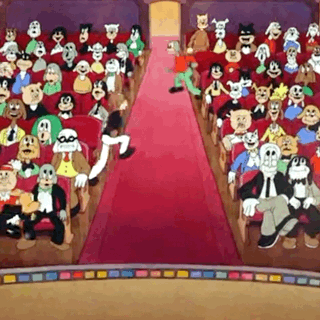
the title song is underscored as we iris in and pan down to the outside of a movie theater, advertising 36 HOURS TO KILL WITH HIS BROTHER’S WIFE (intentionally read as one single title). pan over to the other side: 15 FEATURES 15¢ -- ALSO REJECTED SHORTS (a pun on selected shorts). i believe this gag was in buddy’s theatre as well. inside, reused in bacall to arms, a lone moviegoer gets up and switches his seat. another decides to do the same, and then another, and soon enough the interior of the theater is whipped into a frenzy as everyone scrambles to change seats. a very funny gag with succinct timing. i don’t like comparing everything to tex avery, because friz has just as much talent as tex and i feel like i’m holding tex up as the Ultimate way to do animation, but this gag certainly does feel like an averyism.
one of the many WARMER BROS. puns that we will be seeing in many a short (i believe debuted with hollywood capers? though it could have been from one of the bosko or buddy shorts too) as we open to the beginning of the show, a screen flashing WARMER BROS PRESENTS -- GOOFY-TONE NEWS -- SEES ALL-KNOWS NOTHING. the “sees all - knows nothing” is a take on “sees all, hears all, knows all”, from fox’s movietone news reels back in the day. the puns just keep on coming!

a caricature of movietone news reporter lowell thomas, caricature design courtesy of t. hee, opens us up, billed as dole promise instead. mel blanc provides the vocals as dole announces “good evening, folks. this is, uh...” he pauses, forgetting his own name. the gag is wonderfully structured, as he has a nameplate and a sign posted on his desk, as well as his name posted in big letters right on the screen, yet he still squints at his script with the most analytical, stupefied concentration he can muster. the offscreen whisper of “dole promise!” is just the cherry on top. “oh yeah. this is dole promise, bringing you the latest news events of the day.”
the first news reel: U.S. BUILDS LONGEST LINER IN SHIP BUILDING RACE. wonderful timing (and a neat overhead layout!) as we see the longest liner in person: an extremely elongated ship right in the middle of new york and london. the ship inches forward to london, and then back to new york, and then we cut away to the next order of business. next: FLASH! SPECIAL! heddie camphor (a take on eddie cantor, of course) finds “little oscar”, vitamin (a take on vitaphone) newsreel man gets exclusive interview with oscar. we see a little bug next to a purse (that has the initials of JW on them, jack warner of warner bros fame) and hear mel blanc talking in a russian accent. “ahh, dere you are! tell us, oscar, how does feel for to be back home after being lost for such long time?” the little bug rambles on in high pitched, nonsensical garbles. “oh, thank you very much, oscar! how you like that? he say he would rather be lost!” i haven’t found anything as to what the gag means, so unfortunately the meaning has been lost to the sands of time. but, if anything, it’s amusing hearing mel do one of the voices we’ll be hearing so often in many cartoons.
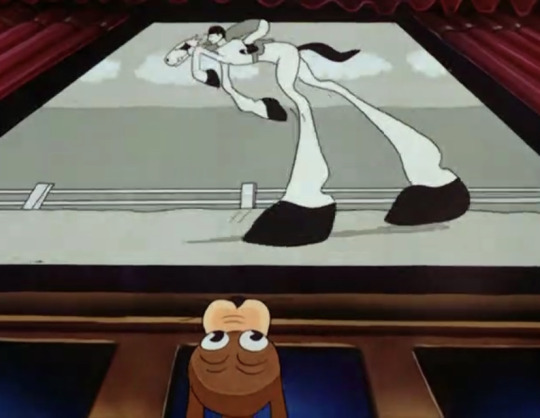
what is it with movie-centric cartoons and hitler? bosko’s picture show in 1933 was the first cartoon of any studio to ever depict a caricature of hitler, and now we have a gag where a man is invited to sit in the last seat in the row. unfortunately, his view is seldom ideal: we see some rather impressive perspective and animation as hitler on screen marches forward, eventually disappearing into nothingness because the moviegoer can’t see anything. aggravated, he moves a few seats down, right in the front row and in the middle. i believe this is bob mckimson animation--this scene would be reused two years later in the film fan, with porky in place of the dog trying to crane his neck to see animation of a jockey riding on the horse. the warped perspective is quite impressive and does a good job of hitting home. we’ve all been there, stuck in the front row and trying to see what’s happening. nevertheless, the dog begrudgingly accepts his fate, forever doomed to view the news reel at inadequate angles.
also reused in bacall to arms is a gag of a hippo trying to get out of the row, proving to be a nuisance in the process. he’s a polite nuisance, at least, repeating “pardon. pardon me. pardon.” as he bulldozes his way through. tex avery would also lampoon overweight hippo moviegoers in his hamateur night in 1939.

time for the birth of a caricature! we have our first caricature of vaudevillain lew lehr (penned as who dehr in this case), whose catchphrase “monkeys is da cwaziest peoples!” would be lampooned in many, many, many, MANY warner bros cartoons (especially bob clampett cartoons: porky in egypt, porky’s snooze reel, russian rhapsody, and so forth). here, he opens us up with nit-wit news. “ladies and peoples, listen while explaining you the latest news of da day.” the napoleon hat/garb in general is a nice touch, often used to symbolize insanity (like porky suffering here from the “desert madness”).
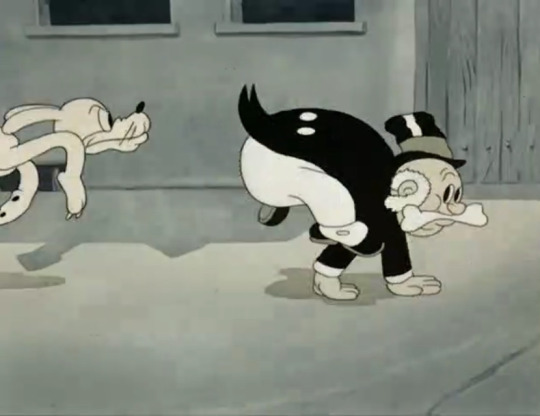
lehr (or in this case dehr) narrates the malady of a strange dog bite affecting the city of “boondoggle”, mo. that strange malady has turned the citizens of boondoggle into boonDOGS as everyone runs around on all fours. “look at dat! even da mayor leads a dog’s life in boondoggle!” the mayor, digging a hole, comes across a dog and growls (i love the detail of his sideburns raising like a dog’s ears in defense), both him and the actual dog engaging in a tussle. the brushing on the fight is very well done for this time period, feeling like a precursor to drybrushing which would be so prevalent in so many cartoons. the mayor wins the fight, running away with a bone in his mouth. elsewhere, BOONDOOGLE'S LEADING SOCIETY MATRON IS LATEST VICTIM OF SCOURGE. amusing animation and narration by blanc/dehr as a woman sits on a pillow, panting like a dog, eagerly running up to her butler and eating a piece of steak thrown at her. dehr wraps up the presentation, he himself getting a taste of the scourge as one of the affected residents crawls onscreen and bites dehr right in the leg. nonsensical? absolutely. but it’s the GOOD kind of nonsensical. the use of black and white is a nice touch with this being a technicolor cartoon. many of the other news reel cartoons have been/are in black and white, so the mixing of technicolor and B&W really adds some authenticity.

“boulevardier from the bronx” seems to be a theme for slow, lumbering characters as the lumbering hippo makes his return, squeezing himself through an angry row of patrons while he dismissively pardons himself. he sits himself down just in time to see “STICKOUTSKI at the fertilizer”. a lion caricature of leopold stokowski invites the moviegoers to a rousing chorus of “she was an acrobat’s daughter”--not unlike bosko getting his own audience to sing in bosko’s picture show. the song is very catchy, the slideshow visuals equally as entertaining as the lyrics. i especially love the gag where one picture, not a part of the slideshow, reads “please do not spit on the floor”, yet the patrons sing it in tune regardless, then correcting themselves and singing the next verse in the same tune. a hilarious gag with great timing. a short merrie melody for sure, but a good one at that.

next is a parody of the MGM lion, crowing like a rooster instead of doing its signature roar. the film is “petrified florist, a take on “petrified forest” (which would be used as a gag in book revue). after an interminable cast scroll through (reused in bacall to arms), we see the star of the film, a caricature of leslie howard unsuccessfully hitchhiking, tying his thumb to a railroad crossing sign, making the light swing. while the film is playing, a random donkey decides to peddle peanuts, crackerjack, chewing gum (with an underscore of “puddin’ head jones”, a favorite of mine). the donkey is booted out of the theater, hitting his head on a streetlight and still repeating his peauts, crackerjack, chewing gum mantra in a daze. a little incongruous and random, but there are some interesting angles and closeups as the donkey walks straight towards the audience.
back to the film, the leslie howard caricature summons a bette davis cariature (again, caricatures by t. hee), demanding some food. bette flirts with him, smitten. “what’s your name?” “puddin tame. ask me again, and i'll tell you the same.” “are you a poet?” “after a fashion. “ooh, i love poetry!” “would you like me to recite?” “no.” even better than the “no” gag is howard struggling to recite mary had a little lamb regardless. “mary lad a little hamb. mary mad a little amb. mary had... oh, she had a goat.” while leslie struggles to retell the story, bette sighs, completely enamored.
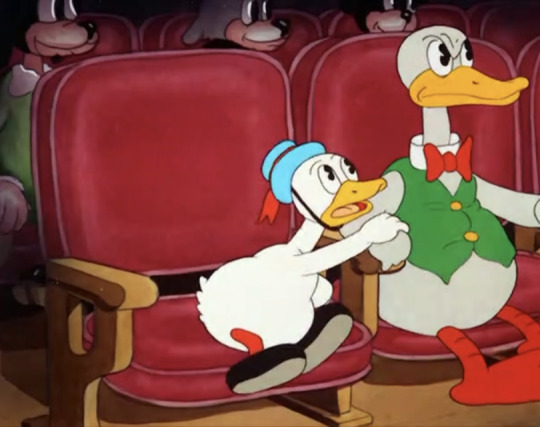
a very interesting discovery, at least for me: i always wondered why in some porky cartoons, porky had a little white duck sidekick (not daffy) who was a pest. mainly a 1939 phenomenon: i’ve only spotted him in it’s an ill wind and porky’s hotel. his name is either dizzy or dippy duck, i can’t remember. but i always wondered why he was porky’s sidekick when daffy was getting to be established as porky’s sidekick at the same time. turns out THIS dizzy/dippy duck’s first appearance, or at least a prototype. here, he pesters his dad, barraging him with questions. “why, daddy? why did the man look at her like that, daddy? why, daddy? does he like her, daddy? does he like the lady, daddy?” and so on. while the dad furiously attempts to hush his kid, his efforts are futile. the duck is only silenced once the entire row in front of him turns back to shoot him down with glares. that is, until the duck starts rambling again, asking a bunch of obnoxious questions. i love this in particular, for i can relate--weird anecdote, but my mom said the first movie she took me to i started walking up and down the aisles and chatting up strangers. so i like this kid! even better is when the angry front row shushes him once more with angry “NYEHHHH!”s. now, the father speaks up in a w.c. fields voice. “heyyy, what’s going on?” a punch to the face from an offscreen fist.

the kid, not getting the memo, pesters his dad once more, who shooes him away. now, the kid darts out of the theater and up to the projection booth. i love the animation of the kid turning his head in wonderment, staring at the door (bob mckimson maybe? it’s pretty solid and constructed). he barges in, fiddling with the controls. he turns a lever from MED. to FAST, and the movie is sped up to frightening speeds. the kid panics, trying to fix his error, but to no avail. now, the movie plays backwards. the animation is quite good--skipping and jumping around, but still room for there to be inbetweens of SOME sort. i can only imagine trying to sort those frames out in the (in)correct order! it’s easy to mess up, but hard to mess up on purpose!
now desperate, the kid sticks his beak inside the projection camera, where it gets caught. in a similar (yet less gruesome/strange) manner to baby bottleneck, the kid gets caught in the gears, his body twisting up and down and around, feathers expelled into the air. iris out as the kid flops to the ground, unscathed, cursing as his body is covered in film.
this cartoon is a GREAT one, probably the best we’ve seen from friz. or, at the very least, the funniest. it’s so ahead of it’s time--so much so that it was reused in chunks in bacall to arms in 1946, which proved to be quite anachronistic. you have the conflicting styles of clampett/davis (mainly clampett, this is probably the most clampett-y short in terms of looks out of the ones he didn’t finish) from 1946, and the simplistic 1937 friz style. that’s QUITE a contrast, but that tells you how well the humor holds up. i’m really fascinated by the dizzy/dippy prototype. in all likelihood, it was just a one off character. friz didn’t sit down thinking this would be his next star (our next review will cover talkative, famous ducks ;)), but he is VERY similar to the duck used in hardaway/dalton’s it’s an ill wind and later clampett’s duck used in porky’s hotel. i believe mel does almost all the voices, save for bette davis. i don’t believe the w.c. fields voice provided by the father duck is tedd pierce. it’s very exciting to see him climb up the ranks--next cartoon, he gets to voice our favorite pig (and duck!) in all, this is a hilarious cartoon. some of the gags are a little (or a lot) dated, often skewing the joke--i wish i knew what the meaning behind the little oscar joke was--but it wasn’t a constant thing. the song number was hilarious (i love the “please do not spit on the floor” gag) and catchy, the animation was good, the caricatures were lovely... while there are many more funny cartoons than this one, in terms of this time period and comparing it to what friz has churned out up to this point, it’s probably his funniest one yet, and that in itself constitutes a watch. it’s definitely the funniest news reel cartoon we’ve seen so far. go for it!
link!
13 notes
·
View notes
Text
History for Granted, or When a Marginal Voice Tackles The Main Text
My thoughts about being a marginalised creator who chose to make a graphic novel on a historical figure in the dominant Western canon. About why I didn't choose a lesser-known history instead. About why, either way, it is not a loss to POC representation
Reposted from my official blog, where I keep all my long-form thoughts.
Some of you may know I write historical fiction. Some of you may also know I’ve been chipping away on an Alexander the Great graphic novel.
My role as a historical graphic novelist has been stewing in the back of my mind for a while now. Actually, the stewing began when I first thought of The Carpet Merchant of Konstantiniyya, but I already know my insights from that project. Be actively thoughtful. Be self aware of how your own biases and societal context influence your storytelling. Recognise the people before and around you. Use your power to bring up voices. Understand that the work of being a responsible author lasts beyond the final page of your story.
Such is the case for Alexander, The Servant and The Water of Life. What I have learnt from TCM still carries over, thank goodness.
However, since last November, I realised that Alexander is a different kettle of fish. I already knew this early on: the mindboggling breadth and scope of research material, the baggage carried by the subject, and the newness of everything. While TCM focused on a narrow historical context (Ottoman era Istanbulite migrates to Georgian era England), and had the advantage of me knowing the lead character for years prior (Zeynel, my precious nerd son…), Alexander was from scratch. I didn’t know just how many Alexander Romances I really needed to read. I didn’t know much about ancient Greek anything. I didn’t know an atom about Alexander the Great himself – really, it was zilch.
Which means my responsibilities this time have a somewhat different character. A different edge.
I don’t write historical fiction about royalties or the elite. The most I have ever been interested in is a well-to-do merchant. Even then, my merchant would have an uncommon edge; he is with the common people. That’s where my interests lie: in the common people. The ordinary people outside of the court who go about their daily ordinary lives and daily ordinary struggles. The ups and downs and ins and outs of aristocrats and royals don’t excite me as much.
Then why Alexander? Honestly, he’s an exception.
Not because he’s suddenly a royal that interests me. Seriously, no royal will ever interest me enough to make a GN out of their life, based on their biography alone. (Though King James of the King James Bible and the secret tunnel to his boyfriend make a convincing petition) Alexander came to me in a roundabout way. A trick. He fooled me to exception by showing me his resume: Macedonian king, prophecised Egyptian pharoah, Persian king, son of a god, Jewish convert, Christian hero, Muslim prophet. And he showed me how many different cultures have absorbed him into their folk mythology over 2000 years. Even as the world changed and his body laid somewhere in Egypt, his shade travelled the world. He’s the only secular figure with similar cultural-legendary reach as Jesus. King Arthur can’t claim that. Heck, even Odysseus can’t claim that. Oh, how could I have resisted? This is exactly what I am all about.

This is all Alexander by the way.
The common people’s Alexander. The story of how different places have appropriated and localised him over time. Gave him different faces. Gave him slightly different names. Gave him quests and adventures and stories that had absolutely nothing to do with ancient Greece. Made him the believer of a pantheon into a believer of a singular God.
What brought me here is this literal embodiment of world literature. But he’s not an epic. He’s popular legend. And he doesn’t belong to any one culture or time or place. He’s everywhere.
But like I said, this kettle of fish is different.
Alexander the Great is not exactly the most obscure of histories. He’s a military idol. A national figurehead. He was a man. He was from ancient Greece. He’s claimed as a “heritage of the Western (read: white) world”, an excuse for why conquest is the legacy of the white, Western man. This is Alexander’s baggage, as I call it.
As a woman of colour (WOC) author from the global south, I’m aware of my (small, individual amount of) power to bring up unheard of histories. Unseen biographies of little known people. A glimpse into outside cultures and voices that Western-dominated media and education gloss over like wallpaper. I could have written about Puteri Gunung Ledang, or May 13th 1969, or the history of how my family came to Malaysia sometime during the Xinhai Revolution. I have no obligation to write about Alexander, because until last November, he was seriously a cultural nobody to me. I have no stake in the furthering the hegemony of Western history.
And I think, maybe not owning that stake is why it’s necessary.
Just as important as minorities writing about little known histories, minorities should write about the histories that are taken for granted. Because of our unique experiences with the consequences of colonialism, slavery, violence, discrimination, dehumanisation, etc, we look at history differently. It’s not about who wins or who loses. It’s about who is missing, who is harmed, what is lost…the gaps made by what was edited out.
With those glasses on, history taken for granted – if not already thoroughly given a critical cleansing – is shown to be what it really is: a history that isn’t as well-known as we thought. (and that’s okay)
I won’t be alone in saying I had no clue Alexander belonged to nobody and everybody (because everyone in the old world has an Alexander). For a long time, Western white history was gatekept, using the reasoning that whatever they claimed had an easy connect-the-dots relationship to their present day (even though I always knew that claim was oversimplified, anti-intellectual thinking). But, all of these things are simply whitewashed facades. The truth is that, like Greco-Roman everything, like Norse history, like Christian destiny, they are more complex, more diverse, more ambiguous, than what these facades can contain.
Just working with Alexander through the framework of the Alexander Romance already blows up general misconceptions about history: that history was a bubble, homogenous and separated from each other (“Egyptian history” “Chinese history” “Roman history”, “Christian world”, “Muslim world” “East”, “West”), rarely interacting and influencing.
And looking at Alexander’s actual biography says a lot about how open the world already was in his time. He was king of three empires. His pre-Hellenistic world was multicultural and diverse. It wasn’t all white marble statues. It was, like what reality is, painted technicolour marble statues.
The Victorian era archeologists who whitewashed those statues stripped off more than just the colour. They took off knowledge.
After a lot of thinking, I feel like I’m in a good place to make a GN about Alexander and the Alexander Romance.
It’s not a confidence thing, though tbh, I believe that as a WOC creator from the global south I cannot afford to doubt myself. It’s more about the position I am in and the new perspective I can offer about a historical-legendary figure taken for granted. And there’s my endless well of passion for multicolour histories. Alongside my desire to decolonialise everything.
It’s not a loss that I have chosen to work on a history taken for granted. Historical GNs are still dominated by the white Western cis-male perspective, both in subject and authorship. To be clear, I wouldn’t consider that particular perspective wrong or lesser on its own. My only qualm is when that perspective becomes the majority perspective, or worst the only perspective, which is given to an audience. I always think about this TED Talk by Chimamanda Adichie, about the Danger of a Single Story:
youtube
Me being here, telling an entirely different story, is a statement by itself.
Even then, I shouldn’t need to justify my choice. Whether it’s to a person who tells me I shouldn’t pursue Alexander because he’s a part of the dominant narrative, or to another person who tells me that as a minority creator I must adhere to my social responsibility (responsibility demanded by whom?) to tell little known histories or stories. Again, in my case, I think it’s not a loss which way I go, Alexander or not, because whatever I write is going to be a different story.
I think the only loss is when there aren’t still yet more marginalised authors to take on both the little known histories and histories taken for granted. The project of diversifying storytelling is not demanding the few marginalised voices to choose the correct, exotic, culturally-representative dish they had to bring to the potluck, but making the table wider, inviting more voices, so that, by author’s choice, any dish can be present and enjoyed by everyone.
My choice in whatever story I desire to write, as long as it doesn’t bring harm and intolerance and it undergoes the necessary self-interrogation, should be a choice that is already given. If white, Western authors can have this freedom, why not everyone else? Why must minority voices be defaulted to never having this good faith at the start?
Is it not enough that we already suffer from a lack of representation and a lack of self-esteem? Must our hands be tied even tighter, to be told that even our own voice cannot be trusted, because that trust has been abused over and over by the dominant voice?
Every new voice that is encouraged to speak is one more step towards making the table bigger.
This is one of my responsibilities of being a (historical) graphic novelist. I am here to encourage, and to make the table bigger. I am here to say, oh look, this particular history is exciting too, see how weird and creative and large the world already was.
And for Alexander GN in particular, it’s about showing that we have shared a historical-literary figure. That Alexander (and his baggage) isn’t immune to criticism. That by bringing him back the way I’m planning to, I’m no longer just talking about Alexander of Macedon. I am talking about Sikandar. I am talking about Alisaunder. I am talking about the Alexander conceptualised by Nizami, by Arrian, by Joseph Flavius, by every hand who has ever written and drew their own Alexander.*
Already, is that not a hundred different stories? * despite the fact all of these voices were male…well that’s gonna change
There will be time for me to write of lesser-known histories, if I feel the calling. Maybe I won’t ever. (I did tell myself The Carpet Merchant was the last historical GN I’ll ever do in forever…here I am. Nothing is predicted.) And if I’m not compelled, again, that is not a loss.
I am not the only one with a voice.
54 notes
·
View notes
Text
okay, I know I’ve mentioned it before that I find the criticisms of ‘joker’ very shallow and misleading - but this is the top review on rotten tomatoes...

...and I feel the need to repeat myself again. This isn’t the only one of its kind, but it’s the most popular I’ve seen. Every media outlet has written about a similar topic in some shape or form.
So I’ve read the article, hidden behind a paywall as it is, and I take serious issue with the damaging message the author took from the film. I’ve copied the article bit by bit because I’m so fucking irritated by it.
For it is essentially a depiction of what happens when white supremacy is left unchecked. It shows the delusions that many white men have about their place in society and the brutality that can result when that place is denied.
Arthur Fleck doesn’t want to be treated better because of the colour of his skin. He doesn’t ask for help because he feels he’s superior to the POC around him. He needs help because he’s ill and no one cares. The film is a criticism of austerity and classism, and the unsympathetic arrogance of those in more fortunate positions than others. It’s also, more importantly, about how all this affects a mentally ill loner with a history of childhood abuse and living in poverty.
It has nothing to do with his race. The author’s words imply that a white person in such a desperate situation is only seeking to affirm their own supremacy. That’s....so fucked up. Mental illness isn’t some tool to be used in a race war, it hurts anyone. He’s dismissing the experiences of a man who happens to be white because he can’t see beyond the colour of his skin. Doesn’t that sound like exactly the kind of thing POC have been fighting against for decades, if not centuries?
The fact that the Joker is a white man is central to the film’s plot. A black man in Gotham City (really, New York) in 1981 suffering from the same mysterious mental illnesses as Fleck would be homeless and invisible. He wouldn’t be turned into a public figure who could incite an entire city to rise up against the wealthy. Black men dealing with Fleck’s conditions are often cast aside by society, ending up on the streets or in jail, as studies have shown.
And though Fleck says he often feels invisible, had he been black, he truly would have been — except, of course, when he came into contact with the police.
Arthur is invisible. It’s painfully obvious that he is. He incites a movement because of what he symbolises and the way Thomas Wayne dismissed people like him. When he murdered the three rich boys on the subway, only his clown makeup was identified. The police weren’t looking for a man of any specific colour, they were looking for a fucking clown.
Arthur could have been black, brown, red or blue. The face behind the mask doesn’t matter, because Gotham City united behind the icon of resistance. It’s supposed to be ironic. The only way Arthur felt seen was when he was under his mask. Nobody cared about Arthur Fleck, they cared about the Joker.
So yes, had Arthur been a black man, he’d still become the symbol of resistance.
Though Fleck is pursued and investigated by Gotham’s finest, his whiteness acts as a force field, protecting him as he engages in the violent acts of the latter half of the film. Consider his appearance on the live talk show hosted by Murray Franklin (Robert De Niro). A black man acting as strangely as Fleck does would not have been allowed to go on the air. But the white Fleck is given access, and bloodshed soon follows.
I mean, in regards to how strangely he was acting, the reason they invited him to the show was because they thought he was a freak. They wanted him to make a fool of himself. Also Murray’s producer never wanted him on the air, but Murray insisted because he was more concerned with viewership. Again - that’s the fucking point. Murray was far too invested in his own self-interest to see a man dangerously close to snapping. The author completely glossed over that, and the producer who didn’t want Arthur, white skin and all.
Or look at how Fleck interacts with others. He is frequently in conversation with people who occupy a lower rung in society than he does: a state-appointed therapist he sees early on; a protective mother who chastises him for playing peekaboo with her son on the bus; his possible love interest, a neighbor who lives in the same building; and the psychiatrist he sees in Arkham Asylum. Every one of these characters is a black woman with whom he eventually has confrontations. Phillips consistently places Fleck in an oppositional or antagonistic position to these women.
I don’t know if this is intentional on Phillips’s part, but it is significant. When we learn that his relationship with the neighbor (played with artful restraint by Zazie Beetz) was merely a figment of his troubled imagination, the way he leaves the apartment implies that this realization has led Fleck to kill her and perhaps her child. After his final conversation with the Arkham doctor, his bloody footsteps suggest that he kills her as well.
A key fact the author conveniently ignores in his article is that Arthur never blames immigrants or POC for his misfortune. When he takes a beating at the hands of non-white kids at the start of his film, his colleague calls them “animals” (a common racist term for non-white folks) but Arthur insists they’re just kids. He sympathises with them, despite the fact they brutalised him, because he doesn’t see them as an ‘other.’
And I do think that’s why, crucially, most of the female characters are black women. Whether they occupy a lower rung of society than he does is debatable, because he’s constantly framed as being in the same situation as them. He’s as impacted by the austerity cuts as they are, he rides the bus as they do, he lives in the same shitty building as they do. To quote his therapist: “they don’t give a shit about you, and they don’t give a shit about me, either.”
Arthur doesn’t just have confrontations with them, he has an imaginary relationship with one. Whether he murders her or not is left ambiguous and up to the audience to decide her fate. We can’t say for sure that she’s dead, and that’s the theme of the entire film. We have no idea if anything is real or all in his head when he’s in the asylum.
And that’s the brilliant point.
Arthur’s world is dominated by black women because black women are one of the minorities most affected by institutional prejudice, facing discrimination for both their race and their gender. In 1970s America, they were some of the most invisible people around, ignored by the wealthy and powerful. So Arthur relates to them.
Phillips’ decision to use black women offers a double message that they, too, are suffering under austerity and classism. This isn’t just a white lonesome man’s struggle, it’s a reality for black women everywhere. Arthur’s situation isn’t exceptional because your neighbour, your therapist, the woman on your bus with her kid - they’re all going through it without going on a murderous rampage. If you feel for Arthur’s plight, you feel for theirs too. It’s fucking brilliant.
As for why he has confrontations with them - he has confrontations with literally everyone. Literally everyone treats him badly. Again, that’s. the. point. Except for the black man at Arkham Asylum who tells him to go get help, who’s just doing his job and feels pity for Arthur. But hey, the author ignores that.
Fleck kills white men because he cannot access their status and is ostracized by them, but his black female victims are so invisible that the film does not bother to show their deaths. We as viewers can and should take note of them.
Arthur killed the three white boys on the subway because they were beating the shit out of him for no other reason than him laughing. They were cruel and sadistic, and he’d just been fired from the job he loved so was on his last nerve. He killed his white ex-colleague for framing him and having the balls to still ask him to lie on his behalf so he could keep his job, when he had Arthur fired. He killed Murray for demeaning him and mocking his plight.
Every person killed on-screen was white. Every person killed on-screen was because Arthur felt they’d done him wrong. Zazie’s character is unconfirmed if dead. The psychiatrist at the asylum is implied to be dead, but Arthur’s transformation to the Joker is complete and it’s entirely possible that the act in itself demonstrates (after having sympathised with black women before) that Arthur’s sanity has cracked and his humanity has been replaced by the chaos of the Joker, who cares little for any life, even that of a marginalised minority he once related to.
There are other ways that whiteness informs Fleck’s character. He anticipates he’ll be treated as a son by the Wayne family, and assumes he’ll be given medical records just by asking the hospital orderly (played by the great Brian Tyree Henry). The privileges that come with Fleck’s race set him up for these unrealistic expectations. When they’re not met, the consequences are deadly.
It’s almost as if Arthur has no concept of reality and has little understanding of the way the world works and naively believes that things will just happen because he wants them to. It’s almost as if he has severe parental issues and was so desperate for a father, he even imagined Murray calling him the son he’d always wanted. It’s almost as if this has been established in the film multiple times.
Whiteness may not have been on the filmmakers’ minds when they made “Joker,” but it is the hidden accomplice that fosters the violence onscreen.
Let’s take a film that offers a brutal outlook on the impact of mental illness on one’s psyche and sanity and demean the entire message, important as it is, and try to steer a much needed conversation on mental health towards something that doesn’t concern it. As a POC, I find articles like this so, so damaging to the fight against racism.
It essentially weakens our arguments and offers ammunition to those that believe POC just hate white people for no other reason than, “ur white and I don’t like it.” Way to go, NYT.
Guaranteed, if Joker had been black or brown and white women were only used, there’d be a backlash against the narrative for painting men of colour as unstable and white women as victims because men of colour aren’t allowed to be mentally ill, only terrorists and criminals. Which is what Joker ultimately ends up becoming. Can’t win, can you?
Thank u for coming to my ted talk.
#sorry I went off#I'm open to valid criticism#but to turn this into a race issue#and ignoring the conversation of mental health#doesn't help anyone#because we NEED to talk about mental health and austerity#it's a VERY REAL ISSUE affecting SO MANY PEOPLE#also people are assholes and we need to try and not be assholes and that's a lesson too lawrence but go off i guess#joker spoilers#go to sleep aly
28 notes
·
View notes